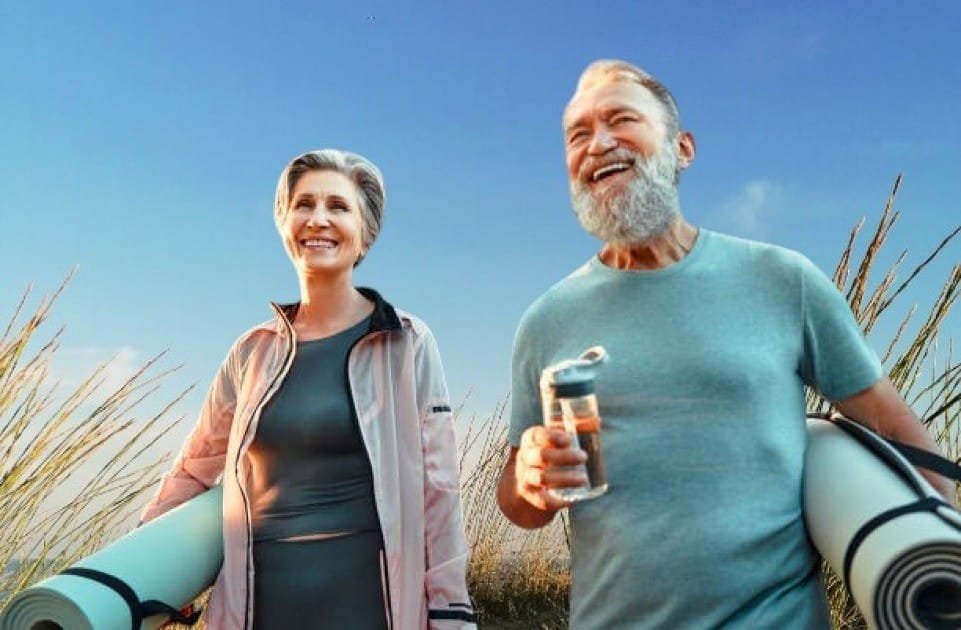Senior fitness promotes body evolution, aging, and cognitive function through tailored strategies like low-impact strength exercises, resistance training, mobility work, and cardiovascular conditioning.
Dr. James Mitchell, a gerontologist at the Longevity Research Institute, emphasizes that consistent exercise not only extends lifespan but also improves health span, ensuring independence and functionality in later years.
Fitness is essential for managing chronic illnesses, with the National Institutes of Health showing moderate physical activity can reduce heart disease, type 2 diabetes, and osteoporosis by over 30%, while cardiovascular conditioning and strength training counteract muscle loss.
Exercise boosts mood by producing mood-boosting neurotransmitters, reducing depression and anxiety symptoms by 40% and slowing cognitive decline in neurodegenerative conditions, according to a study.
Modern exercise science advancements have created adaptive fitness equipment like resistance bands, ellipticals, and stationary bikes, promoting sustainable fitness by incorporating strength, balance, flexibility, and cardiovascular exercise.
In summary, fitness enhances life by reclaiming energy, maintaining independence, and cultivating vitality. Start today for future well-being, as the best investment is in action at present.
The Science of Aging: How Your Body Changes Over Time
Understanding aging’s mechanisms can help individuals maintain vitality and extend their healthspan. Scientific advancements reveal biological changes affecting physical performance, metabolism, and cognitive function, enabling proactive strategies to mitigate their effects.
Metabolic Slowdown: Why Energy Levels Decline
As we age, our metabolism slows, leading to reduced energy production and increased fat storage. To maintain metabolic health, resistance training and protein supplements are essential. Engaging in 150 minutes of moderate activity weekly and strength training twice weekly is also beneficial.
Musculoskeletal Changes: The Shift in Strength and Flexibility
As we age, bone density and muscle mass decrease, increasing the risk of osteoporosis and frailty, and causing sarcopenia, muscle tissue loss, starting in our fourth decade.
Key Factors Contributing to Musculoskeletal Aging:
- Reduced Collagen Production: Affects joint flexibility and skin elasticity.
- Declining Growth Hormones: Slows muscle repair and regeneration.
- Lower Calcium Absorption: Weakens bone integrity over time.
Combining resistance exercises, joint-supporting supplements, and a balanced diet can slow musculoskeletal deterioration, while yoga or Pilates can enhance mobility and posture stability.
Cognitive Function: Why Brain Health Declines & How to Protect It
Research suggests that cognitive aging can be influenced by lifestyle modifications, potentially preserving and even improving mental acuity.
Primary Contributors to Cognitive Aging:
- Reduced Neurotransmitter Activity: Slows communication between brain cells.
- Increased Oxidative Stress: Damages neurons and accelerates cognitive decline.
- Decreased Blood Flow to the Brain: Impacts focus, recall, and mental agility.
Research indicates that incorporating nootropics into cognitive training programs can improve focus and long-term recall, while engaging in brain-challenging activities like language learning and strategic games can also enhance cognitive function.
Hormonal Imbalance: How It Impacts Vitality
Hormone levels change over time, impacting various aspects of an individual’s life, including energy levels, mood stability, and muscle retention.
Notable Hormonal Changes:
- Declining Growth Hormone: Reduces muscle recovery and fat metabolism.
- Lower Testosterone & Estrogen Levels: Impacts muscle density, mood, and stamina.
- Increased Cortisol Levels: Elevates stress and fatigue, hindering recovery.
To maintain hormonal balance, prioritize nutrition, sleep cycles, adaptogenic supplements, stress-management techniques, and consistent sleep patterns. Maintain a cool environment, reduce blue light exposure, and go to bed at the same time each night.
Cardiovascular Adaptations: Why Endurance Shifts Over Time
As we age, vascular elasticity decreases, causing the heart to work harder, leading to higher blood pressure, slower recovery, and reduced aerobic capacity.
Maintaining heart health through endurance-focused exercises like swimming, cycling, and walking, along with heart-supporting supplements like CoQ10 and omega-3s, require daily activity of at least 30 minutes.
Final Thoughts
Aging can be improved through science-backed strategies, understanding metabolic shifts, musculoskeletal changes, cognitive adaptations, hormonal fluctuations, and cardiovascular dynamics. Strength training, supplementation, brain-stimulating activities, and cardiovascular conditioning can help individuals age with strength, resilience, and purpose.
Senior Fitness: 18 Proven Secrets for Unstoppable Vitality & Longevity
The guide emphasizes the importance of fitness after 50 for overall well-being. It provides expert-backed techniques, innovative wellness strategies, and real-world success stories to optimize strength, endurance, and prevent injury, while also offering eighteen proven secrets to rediscover the joy of an active life.
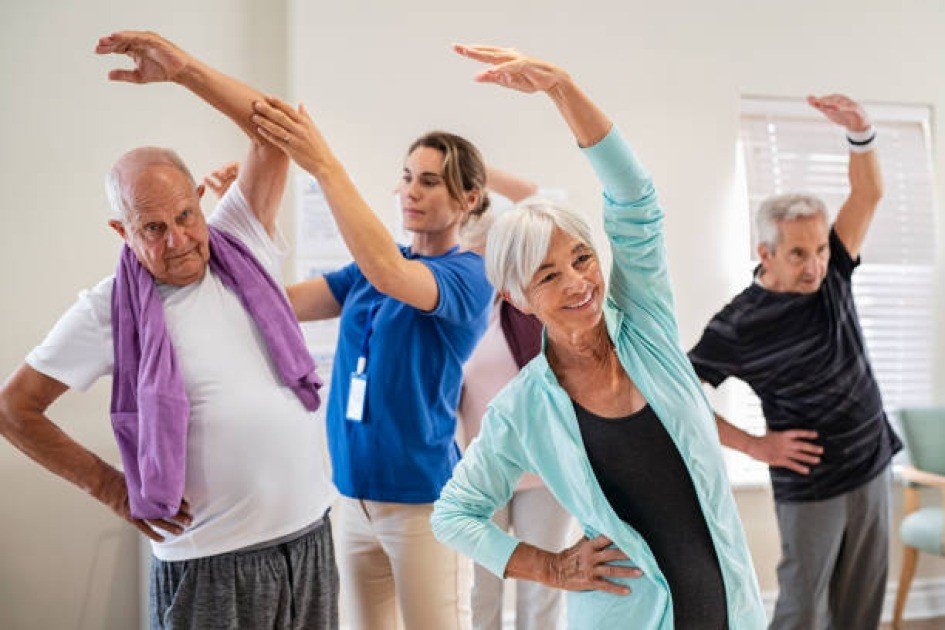
Best Exercises for Aging Bodies
As we age, regular exercise is crucial for maintaining muscle mass, bone density, flexibility, and cardiovascular health. However, selecting safe, effective, and adaptable exercises is essential for long-term health and injury prevention.
Here are the most effective exercises for aging bodies, categorized for optimal health benefits.
Strength Training: Building Muscular Resilience
Why it matters:
Aging accelerates muscle loss, a condition known as sarcopenia, which can be effectively combated through strength training, with adjustable dumbbells providing customized resistance levels.
Best Strength Exercises:
- Bodyweight Squats: Strengthens the legs and enhances mobility.
- Seated Resistance Band Press: Engages the shoulders and chest without excessive strain.
- Dumbbell Deadlifts: Improves posture and lower back strength.
- Wall Push-ups: A gentle yet effective way to build upper body endurance.
Low-Impact Cardio: Supporting Heart Health Without Stressing Joints
Why it matters:
Cardio workouts enhance circulation, endurance, and lung capacity, reducing cardiovascular disease risk. Low-impact alternatives like Recumbent Exercise Bikes are ideal for joint-friendly indoor cardio.
Top Low-Impact Cardio Exercises:
- Brisk Walking: A 30-minute walk daily reduces stroke risk by 20%.
- Elliptical Machine Workouts: Gentle on the knees but great for stamina.
- Swimming & Water Aerobics: Buoyancy reduces joint pressure, making it perfect for arthritis.
- Cycling (Stationary or Outdoor): Enhances cardiovascular endurance while minimizing impact.
Balance and Stability Training: Preventing Falls
Why it matters:
Harvard researchers found that incorporating Stability Balls into routines can improve core activation and reduce fall risk by 37% in the over sixties.
Best Balance Exercises:
- Single-Leg Stands: Improves coordination and ankle strength.
- Heel-to-Toe Walk (Tandem Walking): Enhances proprioception and gait control.
- Tai Chi Movements: A research-backed method to boost both mental and physical balance.
- Standing Heel Raises: Strengthens calves for better support and stability.
Flexibility & Mobility: Keeping Joints Pain-Free
Why it matters:
Flexibility is crucial for preventing stiffness, improving circulation, and reducing injury risk. Mobility exercises, like Yoga Stretching Straps, facilitate joint movement without discomfort.
Top Flexibility & Mobility Exercises:
- Seated Hamstring Stretch: Loosens tight muscles and relieves lower back pain.
- Shoulder Rolls & Arm Circles: Helps maintain upper body flexibility.
- Hip Openers & Gentle Yoga Poses: Improves pelvic mobility and posture.
- Foam Rolling & Myofascial Release: Reduces tension in sore muscles.
Functional Movements: Training for Daily Life
Why it matters:
Functional fitness, involving real-world activities and resistance bands, can improve coordination, strength, and endurance, potentially reducing assisted living care use by up to 45%, according to research.
Best Functional Exercises:
- Chair Sit-to-Stands: Mimics getting up from a seated position.
- Step-Ups on a Low Platform: Simulates climbing stairs.
- Medicine Ball Rotational Twists: Enhances core stability and spinal mobility.
- Farmer’s Carry (Walking with Dumbbells): Builds grip strength and posture.
Movement is the Key to Longevity
Exercise is a crucial investment in long-term well-being, encompassing strength training, cardio, balance work, and functional movements. Including the right equipment, such as Senior-Friendly Exercise Essentials, ensures a safe and effective routine, promoting independence and vitality.
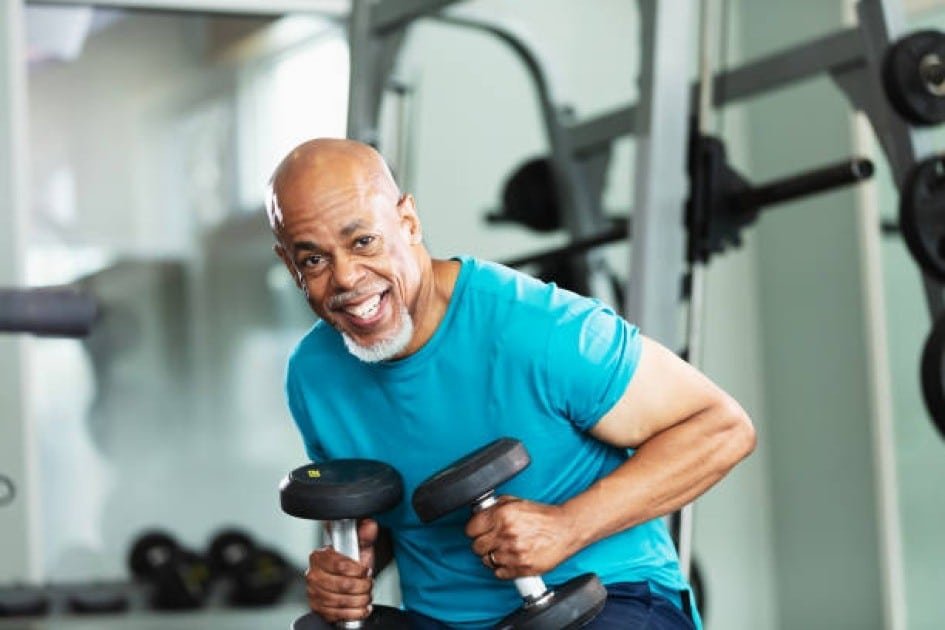
The Power of Strength Training
Strength training is crucial for aging gracefully, promoting mobility, longevity, and preventing health issues. Dr. Emily Carter emphasizes its benefits for seniors, including improved muscle function, reduced fall risk, and cognitive enhancement, making it a valuable tool for aging well.
This section delves into the importance of strength training in a longevity-focused fitness plan and how to effectively incorporate it into your routine.
The Science Behind Strength Training and Aging
As the body ages, sarcopenia occurs, causing a loss of muscle mass in adults over fifty. Progressive resistance training can reverse this, making adjustable dumbbells ideal for at-home strength training without a gym.
A 2023 study in the Journal of Aging Research reveals that strength training not only aids in muscle rebuilding but also enhances bone density, metabolic health, and mental acuity.
Key Benefits of Strength Training for Seniors
A well-structured resistance training program provides numerous benefits:
- Increased Muscle Strength: Maintains independence by making daily tasks effortless.
- Improved Bone Density: Weight-bearing exercises stimulate bone growth, reducing the risk of osteoporosis.
- Enhanced Metabolism: Strength training helps preserve lean muscle mass, which in turn keeps metabolism efficient.
- Better Joint Health: Controlled movements protect the joints and reduce symptoms of arthritis.
- Cognitive Boost: A Harvard Medical School study found that strength training reduces the risk of cognitive decline by promoting better blood flow to the brain.
Strength Training Strategies for Seniors
Safe, structured training, starting with a progressive, low-impact regimen, can eliminate risks and suit your fitness level, despite some fear of injury.
Bodyweight Exercises to Build a Foundation
Resistance bands for seniors offer a low-impact way to build strength without heavy lifting, making it an alternative to traditional weight training methods. Bodyweight exercises provide a safe and effective way to start:
- Chair Squats: Improve leg strength and balance.
- Wall Push-ups: Strengthen the upper body without strain.
- Seated Leg Raises: Engage core and lower body muscles.
Safe Weight Training for Seniors
The lightweight adjustable dumbbells are designed for controlled, joint-friendly weightlifting once a foundation is established. Light weights can enhance results:
Overcoming Common Barriers to Strength Training
Online Senior Strength Training Programs offer personalized workouts with guided coaching to ensure safety, despite proven benefits, despite fear, misconceptions, and past injuries. Below are some ways to address these concerns:
- Concern: “I am too old to start strength training.”
- Reality: A study from the Mayo Clinic Press found that even individuals in their 80s can safely and effectively gain muscle mass.
- Concern: “I might hurt myself.”
- Reality: When performed with proper form and supervision, strength training reduces injury risk by improving joint stability.
How to Get Started with Strength Training Today
Senior-Friendly Home Gym Equipment is an excellent choice for those who prefer home workouts and want to make strength training a habit. Start with two to three sessions per week:
- Consult a physician before beginning a new fitness routine.
- Choose low-impact, controlled movements suited for your fitness level.
- Gradually increase resistance to stimulate muscle growth safely.
- Combine rest and recuperation days for optimal results.
Strength Training Unlocks Long-Term Vitality
Strength training is crucial for maintaining health, mobility, and independence. Personalized strength training programs designed by fitness experts are available for seniors, starting with simple bodyweight movements or light dumbbells.
Strength training can improve mobility, reduce health risks, and enhance overall well-being. Start today to incorporate it into your weekly routine.
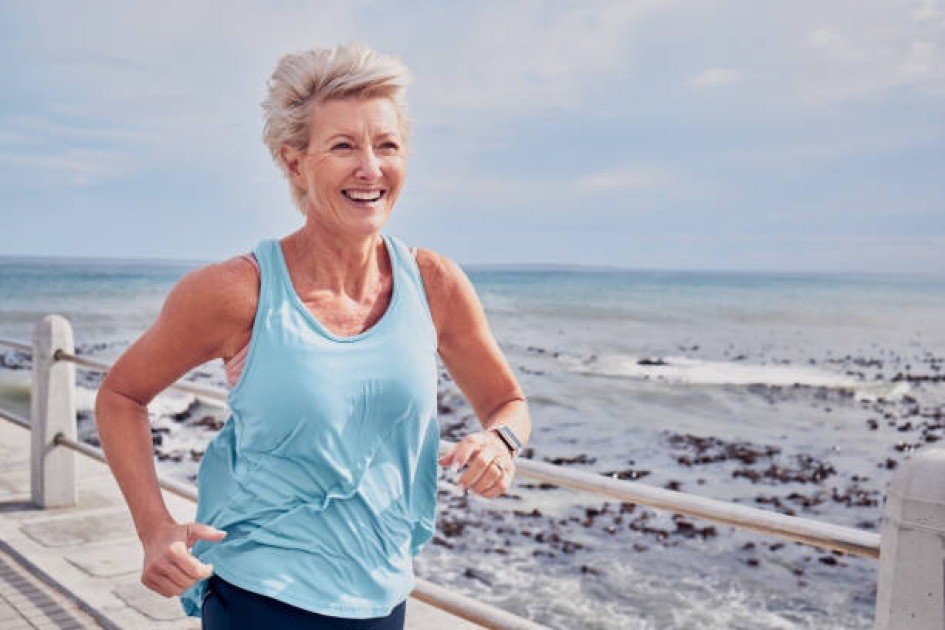
Low-Impact Cardio
Cardiovascular exercise is crucial for heart health, circulation, and endurance, but as the body ages, joint health becomes a concern. Low-impact cardio offers an effective alternative, ensuring joint protection while remaining active.
Why Low-Impact Cardio is Essential for Aging Bodies
Low-impact exercises offer sustainable, long-term solutions for maintaining an active lifestyle, reducing joint stress and providing cardiovascular benefits, unlike high-impact activities like running.
Best Low-Impact Cardio Exercises for Longevity
Low-impact cardio exercises like walking, swimming, cycling, rowing, senior dance classes, and Tai Chi improve cardiovascular health, endurance, mobility, and mental well-being, suitable for seniors, arthritis patients, and mental health sufferers.
Swimming & Water Aerobics
AquaJogger Active Water Exercise Buoyancy Belt enhances cardiovascular endurance, flexibility, and joint stiffness in adults over sixty, while providing buoyancy and proper posture during water workouts.
Cycling: Stationary & Recumbent Bikes
Cycling boosts the heart rate and provides gentle knee and hip support, making recumbent bikes a preferred choice. Schwinn Recumbent Bike Series offers adjustable resistance levels and comfortable back support.
Walking: The Ultimate Functional Movement
Walking is a low-impact cardio activity that improves circulation, bone density, and mental well-being. The American Heart Association suggests that 30 minutes of walking daily can reduce heart disease risk by 35%. Brooks Addiction Walker Shoes offer maximum joint support and stability during walks.
Elliptical Machines: Smooth Motion, Big Benefits
Elliptical trainers, like the Sole Fitness E25 Elliptical Machine, offer a low-impact, fluid workout that mimics natural walking movements, making them ideal for individuals with arthritis or joint pain, as recommended by the Mayo Clinic.
Rowing Machines: Total Body Conditioning
The Concept2 Rowing Machine is a high-quality indoor rower that offers low-impact, full-body training, promoting muscle activation, endurance, flexibility, and core strength without causing joint stress.
Key Benefits of Low-Impact Cardio for Joint Health
Low-impact cardio is essential for senior fitness, promoting circulation, muscle strength, flexibility, and energy levels, while alleviating chronic pain and reducing stiffness in older joints.
This approach allows seniors to maintain their quality of life while supporting their joints in a gentle, sustainable manner. It empowers older adults to remain active, feel younger, and live life to the fullest without injury.
Reduced Inflammation and Joint Pain
Low-impact exercises are beneficial for managing conditions like osteoarthritis as they reduce joint inflammation risk.
Enhanced Cardiovascular Efficiency
Consistent low-impact cardio is proven to enhance heart function and decrease the likelihood of stroke or heart disease.
Improved Mobility and Balance
Water aerobics and cycling are beneficial activities that promote flexibility, coordination, and balance, which are essential for preventing falls and injuries.
How to Maximize Your Low-Impact Cardio Routine
Low-impact cardio enhances health, joint protection, and endurance without excessive force, while maintaining consistency in daily movement and posture. Transitioning from high-impact workouts requires patience and a strategic mix.
Use Proper Equipment
The use of appropriate footwear and joint-friendly workout machines significantly enhances comfort and effectiveness.
Focus on Form and Posture
Proper posture is crucial for maintaining alignment of joints and reducing unnecessary strain.
Gradually Increase Duration and Intensity
Starting with 15-minute sessions and gradually increasing to 30-45 minutes can help the body adapt without overstressing the joints.
Stay Hydrated and Nourished
Hydration aids joint lubrication and performance, while omega-3 fatty acid-rich foods like salmon and flaxseeds can reduce inflammation.
Overcoming Common Barriers to Low-Impact Cardio
Low-impact cardio offers a safe, effective solution for joint pain and mobility issues, lubricating joints, strengthening muscles, improving flexibility, increasing stamina, reducing stiffness, and boosting energy.
“I’m Not Motivated to Exercise”
Setting achievable goals, engaging in enjoyable activities, joining fitness communities, and using wearables like the Fitbit Inspire 3 Health & Fitness Tracker can boost adherence to fitness routines.
Sustainable Fitness for Lasting Mobility
Low-impact cardio is crucial for maintaining an active, pain-free lifestyle, improving cardiovascular health, enhancing flexibility, and promoting overall well-being by incorporating joint-friendly exercises and proper support.
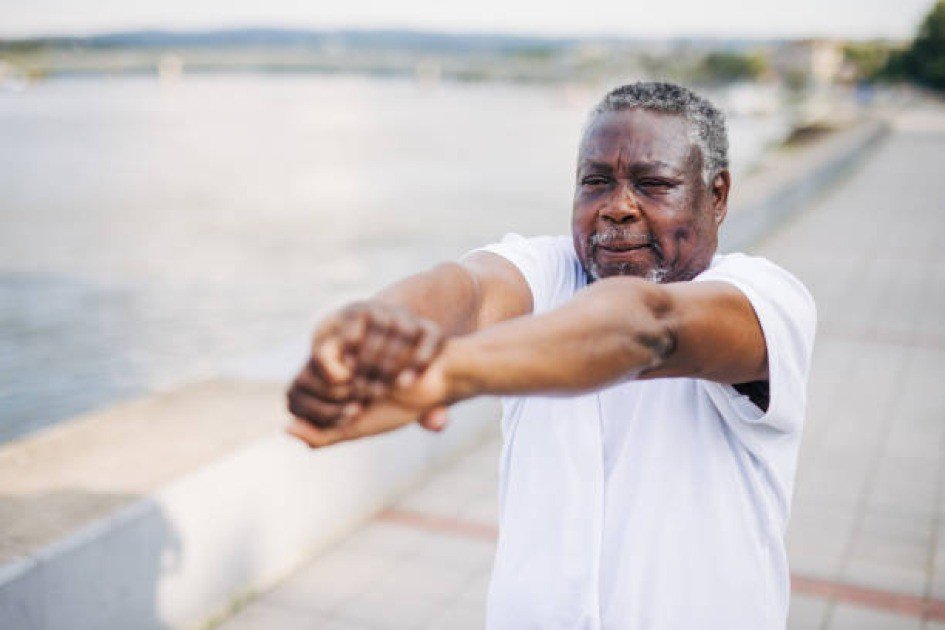
Flexibility & Mobility in Aging Gracefully
Flexibility and mobility are crucial for overall well-being as we age. They help prevent physical limitations and promote independence. This article provides practical advice on incorporating these elements into daily routines.
The Impact of Aging on Flexibility & Mobility
Aging affects joints, muscles, and connective tissue, reducing flexibility and causing discomfort. Regular stretching and mobility exercises can combat these changes, promoting ease in daily activities.
Why Flexibility is Key for Seniors’ Health
Flexibility is vital for posture, balance, and physical function, but limited flexibility increases injury risk. Strengthening exercises improve muscle elongation, reduce tension, and enhance blood circulation.
Mobility Training: A Foundation for Aging Gracefully
Regular mobility exercises, such as walking, dancing, and tai chi, are recommended by the National Institutes of Health to improve joint health, prevent falls, and enhance physical capacity.
Flexibility & Mobility Exercises for Seniors
The following exercises are suitable for seniors seeking to improve their flexibility and mobility without the need for specialized equipment or intense workouts.
Chair Yoga
Chair yoga is a low-impact practice suitable for seniors with limited flexibility or joint pain, improving joint range of motion and flexibility without excessive strain. The Gaiam Essentials Yoga Kit offers a comprehensive yoga experience, including mats, straps, and blocks.
Gentle Stretching Routine
Stretching exercises, especially those targeting the neck, shoulders, and lower back, can help regain and maintain flexibility, but should be done slowly and gradually to prevent injury.
Walking & Low-Impact Cardio
Walking is a beneficial exercise for seniors, enhancing mobility and joint health. Including short walks on varied terrains or light intervals can enhance joint mobility. Fitbit Charge 6 helps track steps, heart rate, and daily mobility progress.
Hip Openers & Leg Swings
Focusing on the hips and legs enhances lower body flexibility, promoting healthy range of motion. Engage in standing leg swings or hip openers for hip flexibility and reduce hip pain.
Maintaining Mobility with the Right Equipment
Fitness products like resistance bands, balance pads, and mobility-specific devices can enhance seniors’ flexibility and mobility, improving range of motion and functional movement.
Resistance Bands
The Fit Simplify Resistance Bands are a cost-effective, user-friendly tool for seniors to enhance muscle strength and flexibility, offering low-impact exercises suitable for all fitness levels.
Balance Pads
Balance training aids in fall prevention and coordination. AIREX Balance Pad provides a stable, challenging surface for flexibility and balance training.
How to Overcome Challenges in Flexibility & Mobility
As we age, a flexible, mobility-focused mindset is crucial for graceful aging, reducing pain and stiffness. Consult a healthcare provider before starting a fitness program.
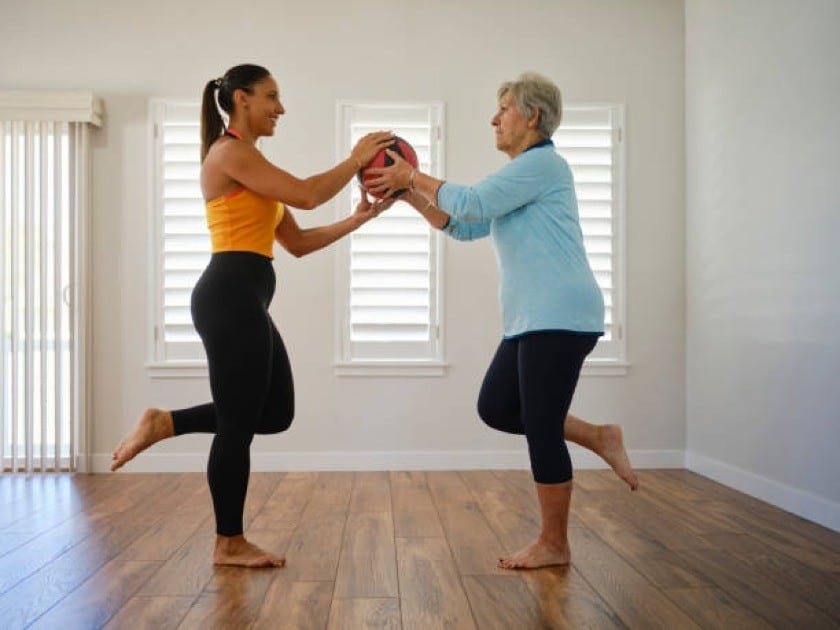
Balance and Stability Training
As seniors age, falls become a major concern, with falls being the leading cause of injury. However, proper balance and stability training can significantly reduce falls and maintain independence, enhancing safety and vitality for seniors.
The Science Behind Falls in Seniors
Falls are linked to muscle weakness, bone density loss, and coordination issues, making balance training crucial for seniors in their fitness routines, especially on slippery floors and uneven surfaces.
Key Exercises for Enhancing Balance and Stability
The inclusion of balanced exercises in daily routines can significantly enhance a senior’s stability and prevent falls. Here are some effective exercises:
Heel-to-Toe Walks
The heel-to-toe walk is a beneficial exercise for seniors, strengthening lower limbs and improving coordination by engaging the core and maintaining balance.
Standing on One Leg
Standing on one leg improves balance and strengthens posture muscles. Start with a chair or wall, lift one leg for 10-15 seconds, then switch legs gradually as strength improves.
Tai Chi
Tai Chi, an ancient Chinese practice involving slow movements and deep breathing, is beneficial for seniors, improving balance, mental clarity, stress reduction, and muscle strength, making it an effective fall prevention method.
Using Adaptive Equipment to Improve Balance
Traditional exercises are effective, but adaptive fitness equipment can provide additional support and guidance for seniors to improve balance and stability. For example:
- Balance Boards: These devices challenge the body’s coordination and strengthen the lower limbs by forcing the individual to stabilize while the board shifts.
- Stability Balls: Sitting on or using a stability ball can engage core muscles, improving posture and balance.
High-quality balance boards like BOSU Balance Trainer and Gaiam Balance Ball are essential for maintaining stable positions in both sitting and standing positions.
Factors That Affect Balance and How to Mitigate Them
Inadequate lighting, slippery floors, and cluttered pathways increase fall risk in seniors. Ensure well-lit, obstacle-free living spaces with grab bars and wear non-slip footwear for slipping prevention.
Staying Consistent: Creating a Long-Term Routine
To maintain motivation and safety, seniors should incorporate balance exercises into their fitness routine, aiming for three weekly sessions, starting with simpler exercises and progressing over time.
The Role of Nutrition and Supplements in Fall Prevention
Nutrition, including calcium, vitamin D, and magnesium, strengthens bones and muscles, reducing fracture risk. Supplements like turmeric capsules help reduce joint pain, promoting balance and movement.
Building Confidence through Balance
Balance training is crucial for seniors to prevent falls and maintain an active lifestyle. It involves targeted exercises, adaptive equipment, and environmental factors.
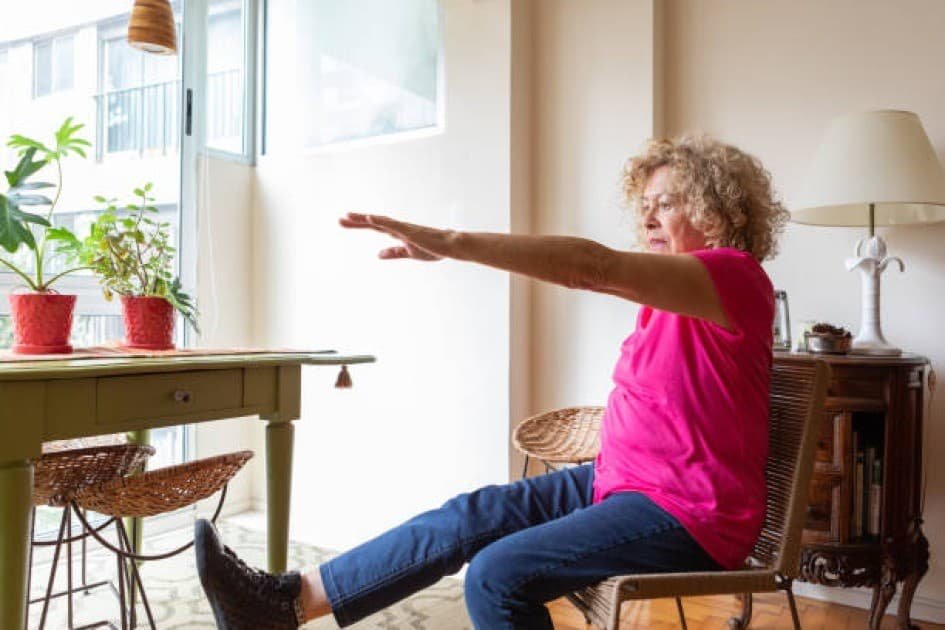
Chair Exercises for Seniors with Limited Mobility
Chair exercises are a practical solution for seniors with limited mobility, offering a low-impact, effective way to stay fit in the comfort of their homes, requiring minimal equipment and catering to different mobility levels.
Why Chair Exercises are Essential for Seniors
Chair exercises offer seniors with joint pain, arthritis, or other physical limitations a safe and enjoyable way to engage in physical activity.
The Benefits of Chair Exercises for Seniors
Engaging in chair exercises provides numerous health benefits:
- Enhanced Flexibility: Gentle movements help improve the range of motion and prevent stiffness.
- Increased Strength: Regular practice can help seniors retain and even build muscle strength, especially in the legs, arms, and core.
- Improved Circulation: Circulating blood throughout the body supports heart health and reduces the risk of blood clots.
- Better Balance and Coordination: Exercises focus on stabilizing muscles, which prevent falls, a major concern for aging individuals.
The benefits not only enhance physical health but also enhance mental well-being, fostering a sense of accomplishment and confidence in seniors.
Best Chair Exercises for Seniors with Limited Mobility
Let us explore some simple exercises that seniors can perform from a seated position, which can be adjusted to suit their individual mobility levels.
Seated Marching
This seated exercise is ideal for seniors with balance or standing issues, mimicking walking motion. Start slowly and gradually increase duration for strength and endurance. To perform this exercise:
- Position yourself upright in a sturdy chair with your feet touching the ground.
- Engage one knee toward your chest, then bring the other knee down.
- Continue alternating knees for 30 seconds, rest, and repeat.
Seated Leg Extensions
Leg extensions are exercises that focus on strengthening the quadriceps, which are essential for maintaining walking ability and overall leg strength. To perform this exercise:
- Sit tall in a chair with both feet flat on the floor.
- Slowly extend one leg straight out, hold for a few seconds, and then return it to the starting position.
- Repeat with the other leg. Perform 10-15 repetitions per leg.
Seated Arm Raises
This upper-body exercise strengthens shoulders and arms, improving functional movements like lifting and reaching. It also engages core muscles by maintaining posture during movement. To perform this exercise:
- Keep your feet on the ground and posture with an erect back.
- Slowly raise both arms overhead as far as comfortable, then lower them back down.
- Repeat 10-12 times.
Seated Knee Lifts
This simple yet effective exercise helps enhance flexibility and strength in the lower body. To perform it:
- Sitting tall with your back against the chair.
- One knee should be raised towards your chest, held for a brief time before being raised.
- Repeat on the opposite side. Do 10-12 repetitions per leg.
Seated Torso Twists
Torso twists engage the obliques and spinal muscles, improving mobility and reducing stiffness in the back. To perform this exercise:
- Keep your feet level and sit with an open plan.
- Slowly twist your torso to the right, hold for a few seconds, and return to the center.
- Repeat to the left. Perform 8-10 twists on each side.
Using Adaptive Equipment to Enhance Chair Exercises
Adaptive equipment and fitness apps offer support and comfort for seniors with limited mobility, while guided chair workout routines cater to those who prefer instruction. Consider the following products:
- Resistance bands are beneficial for adding resistance to chair exercises without overloading the body, enhancing strength, flexibility, and endurance, especially for seniors.
- A high-quality chair cushion is essential for enhancing comfort during seated exercises by providing lumbar support and promoting better posture.
Safety Tips When Doing Chair Exercises
To ensure the health and independence of seniors in their golden years, it is crucial to incorporate chair exercises into their daily routine.
- Choose a Stable Chair: Ensure that the chair is sturdy, with no wheels, to avoid accidents.
- Warm Up Before Exercising: A short warm-up helps prepare your body for movement and reduces the risk of injury.
- Listen to Your Body: Never push through pain; if something feels uncomfortable, stop and consult a healthcare professional.
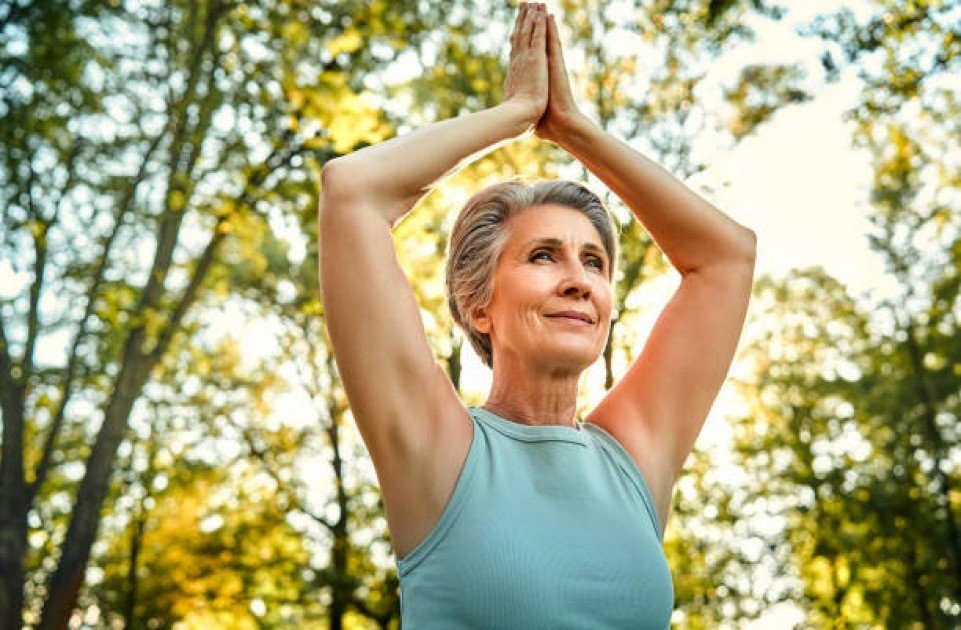
The Mind-Body Connection
Exercise is essential for senior health, promoting cognitive function, mood, and mental clarity, boosting physical vitality and mental agility, and enhancing overall well-being.
The Profound Link Between Physical and Mental Health
Exercise enhances brain plasticity, memory function, and mood regulation, promoting mental clarity and cognitive decline by stimulating neurotrophin production and neuron growth.
Enhancing Memory and Cognitive Function
Exercise improves memory and cognitive processing in seniors by releasing BDNF, counteracting aging decline, and reducing Alzheimer’s and dementia risk. Integrate cardiovascular and strength training for optimal brain health.
Exercise as a Mood Regulator
Exercise, including daily aerobic exercise, can significantly improve mood and mental health in seniors by releasing endorphins, which alleviate symptoms of anxiety, depression, and stress.
Exercise and Neuroprotection: Defending Against Cognitive Decline
Regular exercise promotes neuron growth and synaptic plasticity, reducing brain shrinkage and promoting slower aging processes in seniors, leading to larger hippocampal volumes for memory and learning.
Incorporating Brain-Boosting Exercises into Your Routine
Scientifically proven exercises, including those that target muscles and enhance brain function, have been shown to improve brain health such as:
- Aerobic Exercise: Engaging in aerobic activities like jogging, swimming, or biking boosts brain blood flow, supporting cognitive health. Fitbit Charge 6 helps seniors monitor daily steps, heart rate, and activity.
- Strength Training: Resistance bands for seniors are lightweight, convenient tools for strength training at home, aiding in muscle atrophy, improving circulation, and supporting brain function.
- Mind-Body Exercises: Yoga and Tai Chi practice provide physical and mental benefits, promoting balance, flexibility, and mental clarity. Manduka Yoga Mat is a high-quality mat ideal for seniors.
Reducing the Risk of Cognitive Decline: Scientific Evidence
Regular exercise reduces neurological conditions like Alzheimer’s and Parkinson’s, slows cognitive decline in seniors, and supports the neurovascular network, boosting blood flow to the brain.
A Holistic Approach to Senior Brain Health
Regular exercise improves seniors’ physical strength, endurance, and brain function, promoting a fulfilling lifestyle and protecting their brain health from aging’s effects.
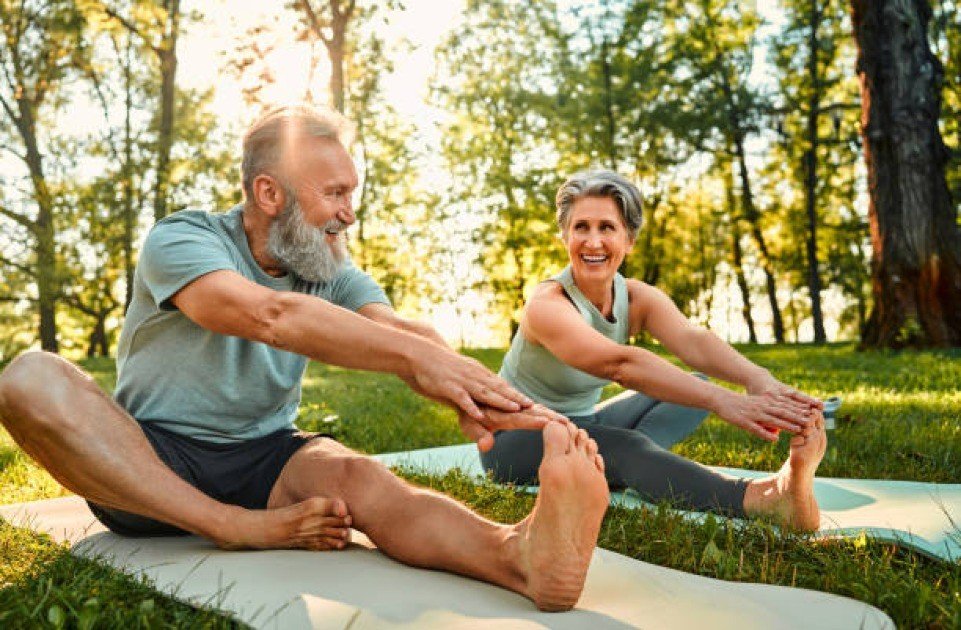
Senior-Friendly Workout Routine
A senior-friendly fitness routine should balance challenge and recovery, promoting vitality, strength, and longevity without risking injury, ensuring overall health and safety.
Assess Your Fitness Level
Assessing physical capabilities and age-related changes is crucial for a personalized fitness routine, with fitness trackers like Fitbit Charge 6 helping monitor progress and prevent overexertion.
Focus on Low-Impact Exercises
The Fitness Tracker for Seniors is a water-resistant device that aids monitoring progress in low-impact exercises, promoting cardiovascular health and maintaining mobility.
Strength Training to Build Muscles
Strength training is essential for seniors to maintain balance and prevent falls, as muscle mass decreases with age. Simple weight exercises like resistance bands improve strength without straining the body.
Prioritize Balance and Flexibility
The Senior Yoga Kit with Props is an excellent senior fitness program that enhances mobility, balance, and flexibility in older adults, thereby reducing the risk of falls through improved posture, muscular stabilization, and flexibility.
Set Realistic and Achievable Goals
MyFitnessPal is a fitness app that assists seniors in setting realistic fitness goals, ensuring consistent improvements over time by setting gradual milestones.
Listen to Your Body and Prioritize Recovery
Compression socks are crucial for senior-friendly fitness programs, aiding muscle recovery and preventing injury. Rest days are essential for maintaining physical health, incorporating stretching or light walking.
Embrace Consistency Over Intensity
Consistency in long-term fitness routines, focusing on lighter activities like stretching, walking, or swimming, is crucial for maintaining fitness longevity and promoting physical activity.
Stay Engaged with Social Fitness Activities
Senior Fitness Class Subscription offers virtual fitness classes for older adults, including water aerobics, chair yoga, and walking clubs, which enhance motivation, social interaction, and emotional well-being, making them beneficial for seniors.
Reassess and Adjust Your Routine Regularly
Regular reassessment of a fitness plan is crucial to adapt to the body’s evolving needs, including new exercises, increasing duration and intensity, and respecting its limitations.
A Routine That Grows with You
A senior-friendly fitness routine involves low-impact exercises, strength training, balance routines, and recovery, focusing on body awareness and consistency. Choose products that align with your lifestyle and prioritize safety to avoid injuries.
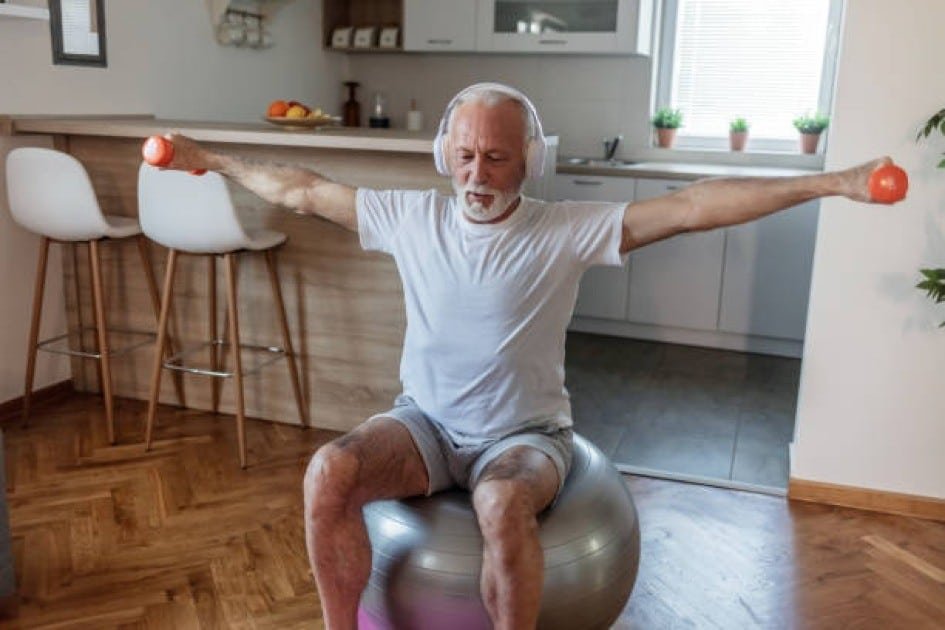
Nutrition for Longevity and Strength
A well-balanced diet is crucial for maintaining strength, vitality, and resilience in later years, requiring careful attention to macronutrient balance, micronutrient intake, and hydration levels.
The Macronutrient Blueprint: Finding the Right Balance
Consuming macronutrients like proteins, carbohydrates, and healthy fats in appropriate amounts is crucial for maintaining optimal health, supporting muscle retention, cognitive function, and energy levels.
- Protein: Muscle mass is crucial for mobility, balance, and metabolic efficiency, and older adults need more protein per meal to enhance muscle protein synthesis.
- Aim for 1.2 to 2.0 grams per kilogram of body weight daily.
- Prioritize high-quality sources such as lean meats, fish, eggs, legumes, and plant-based proteins.
- Consider supplementing with High-Quality Whey or Plant-Based Protein Powders to meet daily requirements efficiently.
- Healthy Fats: Omega-3 fatty acids, particularly EPA and DHA, are known to reduce inflammation, support brain function, and improve heart health, with adequate consumption in seniors enhancing memory retention and cognitive agility.
- Best Sources are Fatty fish (salmon, mackerel), walnuts, flaxseeds, and Metagenics OmegaGenics Fish Oil
- Smart Carbohydrates: It is advised that for long-lasting energy, complex carbs be included instead of processed sweets.
- Opt for fiber-rich foods like quinoa, oats, and sweet potatoes.
- Minimize high-glycemic index foods to avoid blood sugar fluctuations.
- Blood Sugar Support Supplements can further enhance metabolic stability.
The Micronutrient Arsenal: Essential Vitamins and Minerals
Macronutrients provide energy and structural support, while micronutrients ensure cellular efficiency, immune resilience, and optimal organ function.
- Vitamin D and Calcium: As we age, bone density declines, increasing the risk of osteoporosis and fractures. However, adequate Vitamin D levels can reduce fall risk by 20% in older adults.
- Daily intake: 800-1200 IU of Vitamin D and 1000-1300 mg of Calcium.
- Sources: Fatty fish, fortified dairy, leafy greens, and Calcium + Vitamin D Supplements.
- Magnesium: Magnesium, a key mineral in muscle relaxation, sleep, and cardiovascular health, has been linked to a lower risk of hypertension and cognitive decline in a 2022 meta-analysis.
- Best sources: Nuts, seeds, whole grains, and Bioavailable Magnesium Supplements.
- B Vitamins: The B-vitamin complex is vital for nerve function, energy metabolism, and red blood cell production.
- Vitamin B12 deficiency is particularly common, as absorption decreases with age.
- Best sources: Animal products, fortified cereals, and Methylated B-Complex Supplements.
The Role of Hydration in Longevity and Vitality
Dehydration, a prevalent issue affecting cognition, kidney function, and cardiovascular health, is often overlooked by seniors who often fail to consume sufficient fluids daily.
- Daily Goal: Aim for 2.5 to 3 liters of fluids per day, adjusting based on climate, activity level, and medical conditions.
- Best Sources:
- Water-rich foods: Cucumbers, watermelon, oranges, and broth-based soups.
- Electrolyte-infused beverages: Coconut water and Hydration Support Powders.
A Harvard Medical School study found that even mild dehydration can impair cognitive function and lead to fatigue. Thus, staying well-hydrated is one of the simplest yet most effective ways to maintain overall health.
Anti-Inflammatory Nutrition: The Key to Mobility and Comfort
An anti-inflammatory diet can help mitigate chronic inflammation, promote health, energy, and longevity, and is a powerful tool for managing metabolic disorders and cardiovascular diseases.
- Top Anti-Inflammatory Foods:
- Turmeric: Contains curcumin, a powerful anti-inflammatory compound.
- Berries & Leafy Greens: Rich in antioxidants that combat oxidative stress.
- Green Tea & Dark Chocolate: Provide polyphenols that support cellular health.
- Curcumin Supplements can enhance the bioavailability of turmeric’s benefits.
- Avoid:
- Refined sugars and processed foods, which fuel inflammation.
- Excessive alcohol, which depletes essential nutrients.
Personalized Nutrition: A Smarter Approach to Aging Well
Individuals have distinct dietary requirements, genetic predispositions, and metabolic responses, making a one-size-fits-all approach ineffective. gut bacteria diversity is crucial for good health, with diet being the primary driver of this diversity.
- Genetic Testing for Personalized Nutrition: Companies now offer DNA-Based Nutrition Testing Kits that analyze genetic markers to optimize dietary strategies.
- Gut Health Optimization: The gut microbiome directly impacts immune function, nutrient absorption, and inflammation levels.
- Probiotic-rich foods: Yogurt, kefir, fermented vegetables.
- High-Potency Probiotic Supplements can further support digestive health.
Building a Longevity-Focused Nutrition Plan
Nutrition is crucial for seniors’ thriving, ensuring energy, cognitive function, and mobility in their later years by prioritizing whole foods, essential nutrients, and hydration.
To maximize results, integrate a combination of:
- Balanced macronutrients to fuel muscle, brain, and energy levels.
- Essential vitamins and minerals to support bones, metabolism, and cellular health.
- Hydration and anti-inflammatory strategies to optimize daily function.
- Personalized nutrition insights into a science-backed approach to longevity.
Making strategic changes can lead to a future of vitality, independence, and resilience.
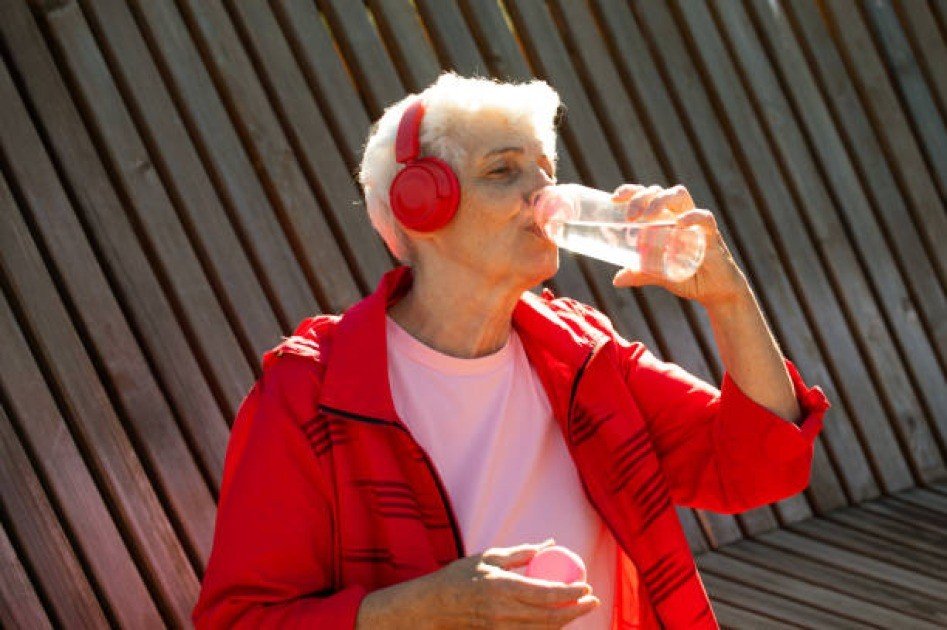
Hydration and Its Role in Senior Fitness
Adequate water intake is crucial for fitness, aging, and overall well-being, while understanding hydration’s science is essential for maximizing fitness potential and preventing dehydration-related issues in older adults.
The Science of Hydration: Why Water Matters More with Age
Aging affects the body’s ability to regulate hydration in several ways:
- Reduced Thirst Mechanism: The sensation of thirst diminishes with age, often leading to underhydration without noticeable symptoms.
- Lower Water Reserves: Muscle tissue holds a significant amount of the body’s water, but as muscle mass declines with age, the body stores less water.
- Kidney Function Changes: Older kidneys become less efficient at conserving water, increasing the risk of dehydration.
Hydration involves maintaining electrolyte balance through Sodium, potassium, and magnesium, ensuring efficient water use. Supplements like Electrolyte Powder and smart water bottles can help maintain this balance.
How Dehydration Impacts Strength, Endurance, and Recovery
Lack of proper hydration can hinder daily activity and workouts. Joint Support Hydration Formula like Collagen + Hyaluronic Acid Hydration Booster and Senior Fitness Hydration Pack are low-sugar electrolyte drinks for seniors.
Here are some impacts from dehydration:
- Muscle Cramping & Weakness: Water helps muscles contract efficiently. Without enough fluids, muscle cramps and early fatigue occur more frequently.
- Joint Stiffness & Pain: Cartilage relies on hydration to stay lubricated. When hydration drops, joint discomfort increases, making movement difficult.
- Reduced Endurance: Studies suggest that a mere 2% decrease in hydration can lead to a 10-20% drop in physical performance.
The Role of Hydration in Cognitive Function and Balance
The Brain Hydration Formula, a Nootropic Electrolyte Mix for Seniors, not only provides physical benefits but also enhances brain function and coordination, preventing falls.
- Memory & Focus: Dehydration can lead to brain fog, slower reaction times, and forgetfulness, which can increase fall risks during workouts.
- Mood Stability: Proper hydration helps regulate mood, stress levels, and energy fluctuations, supporting mental well-being.
- Vertigo Prevention: Dehydration can lower blood pressure and oxygen flow to the brain, increasing the likelihood of dizziness or imbalance.
How Much Water Do Active Older Adults Need?
The guideline recommends eight 8-ounce glasses of hydration daily, but hydration needs may vary based on physical activity, medication use, and climate conditions.
A more personalized approach is:
- Moderate Activity: 2-2.5 liters daily
- Intense Activity: 3+ liters daily
- High-Protein Diet Users: Additional 500ml per day
Wearable hydration tracker for seniors includes hydrating foods like cucumbers, watermelon, oranges, and celery for natural electrolytes and improved absorption.
Practical Hydration Strategies for Optimal Fitness
Incorporate science-backed strategies into your routine to maintain peak fitness levels and stay properly hydrated. Use Electrolyte Infusion Tablets, a sugar-free electrolyte booster for seniors.
- Start Your Day with Water: Drinking 500ml of water first thing in the morning jumpstarts metabolism and rehydrates overnight fluid loss.
- Hydrate Before, During, and After Exercise: Consume 200-300ml every 15-20 minutes during workouts, especially when engaging in Low-Impact Cardio or Strength Training.
- Use a Smart Hydration Reminder: Technology can help track intake. A Smart Water Bottle notifies you when it is time to drink.
- Infuse Water with Electrolytes: Electrolyte powders or natural additions like lemon, mint, or coconut water enhance hydration efficiency.
- Adjust Hydration to Medication Needs: Certain medications like diuretics and blood pressure pills can deplete water levels. Always consult a doctor for personalized guidance.
Hydration as the Foundation of Senior Vitality
Hydration is essential for seniors’ longevity, energy, and physical function, enhancing endurance, joint protection, cognition, and fatigue prevention, and promoting strength training, low-impact cardio, and balance exercises.
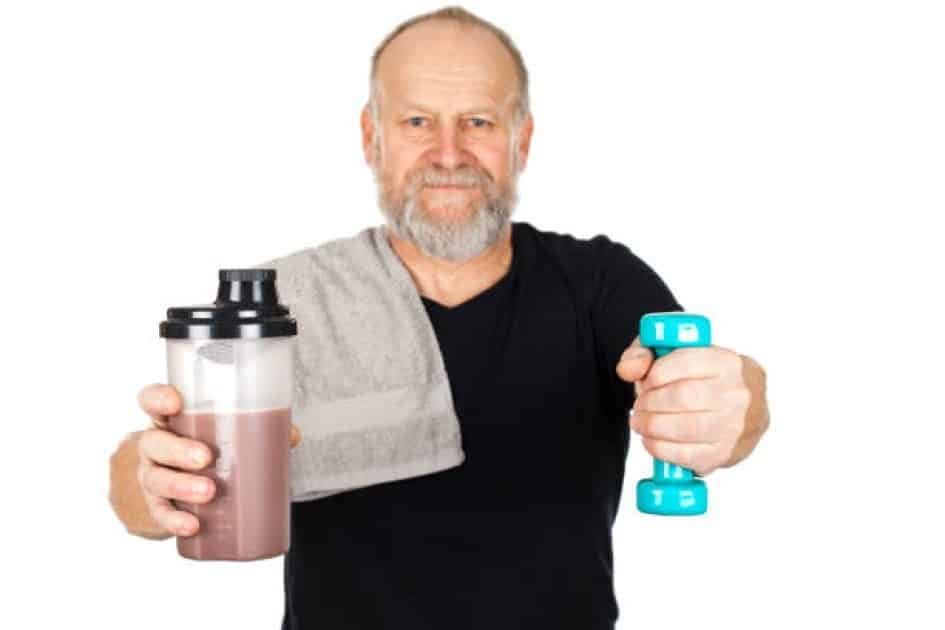
The Role of Supplements in Senior Fitness
Supplements are crucial for maintaining optimal health and longevity, as they help fill nutritional gaps, enhance energy levels, and support muscle strength, joint health, and cognitive function.
Understanding the Need for Supplements
As we age, our body’s metabolic changes affect nutrient absorption and metabolism, necessitating a personalized supplement plan for sustained well-being due to reduced stomach acid production.
Essential Supplements for Optimal Fitness
Supplements for seniors can enhance joint, muscle, heart, and bone health, promoting a more active and fulfilling lifestyle, bridging the gap between sedentary and vital lifestyles.
Protein Supplements for Muscle Maintenance
Sarcopenia, a decline in muscle mass with age, requires a daily protein intake of 1.2 grams per kilogram to support muscle retention and recovery.
Omega-3 Fatty Acids for Joint and Heart Health
Regular intake of omega-3s, including Triple-Strength Omega-3 Capsules, has been found to reduce arthritis-related pain by 38%, according to a 2023 study.
Vitamin D and Calcium for Bone Strength
Vitamin D and calcium supplementation are crucial for bone resilience, as weak bones increase fracture risk. Vitamin D can remarkably increase calcium absorption, potentially boosting it by up to 65%.
Magnesium for Muscle Function and Recovery
Magnesium is crucial for muscle contraction, nerve function, and sleep regulation, and deficiency can lead to muscle cramps, fatigue, and poor sleep quality, affecting an active lifestyle.
Collagen for Joint Mobility and Skin Elasticity
Collagen production declines with age, causing weaker joints and reduced skin elasticity. Hydrolyzed collagen peptides support joint lubrication and skin hydration.
The Science Behind Absorption: Choosing the Right Forms
Supplements vary in quality, with bioavailability being a crucial factor determining the body’s ability to effectively absorb and utilize the nutrient.
- Liposomal Vitamin C is absorbed up to 135% more effectively than standard ascorbic acid.
- Methylated B12 (Methylcobalamin) is more readily used by the body than cyanocobalamin.
- Curcumin with Piperine increases absorption by 2000%, making it a superior choice for inflammation relief.
Potential Risks and How to Avoid Them
Supplements offer numerous advantages, but their excessive or improper use can result in negative interactions or toxicity.
- Watch for Drug Interactions: Certain medications, like blood thinners, may interact with omega-3 supplements, increasing bleeding risk, so it is crucial to consult a healthcare provider before introducing a new supplement regimen.
- Avoid Over-Supplementation: Excessive calcium intake, exceeding 2000mg/day, can potentially lead to kidney stones.
- Prioritize Third-Party Testing: Selecting brands that undergo independent testing for purity and potency guarantees safety and effectiveness.
Incorporating Supplements into Your Routine
- Strategically combining supplements like vitamin D with healthy fats for better absorption and combining them with meals can maximize benefits.
- Start with one supplement at a time to monitor effects and avoid reactions.
- Use a pill organizer to ensure consistency.
- Rotate brands periodically to prevent dependency on specific formulations.
- Monitor progress by tracking energy levels, recovery times, and overall well-being.
Supplements as a Key to Lifelong Fitness
Supplements enhance fitness, longevity, and overall well-being by bridging nutritional gaps and optimizing physical health. Top-rated senior fitness supplements can enhance strength, mobility, and mental clarity.
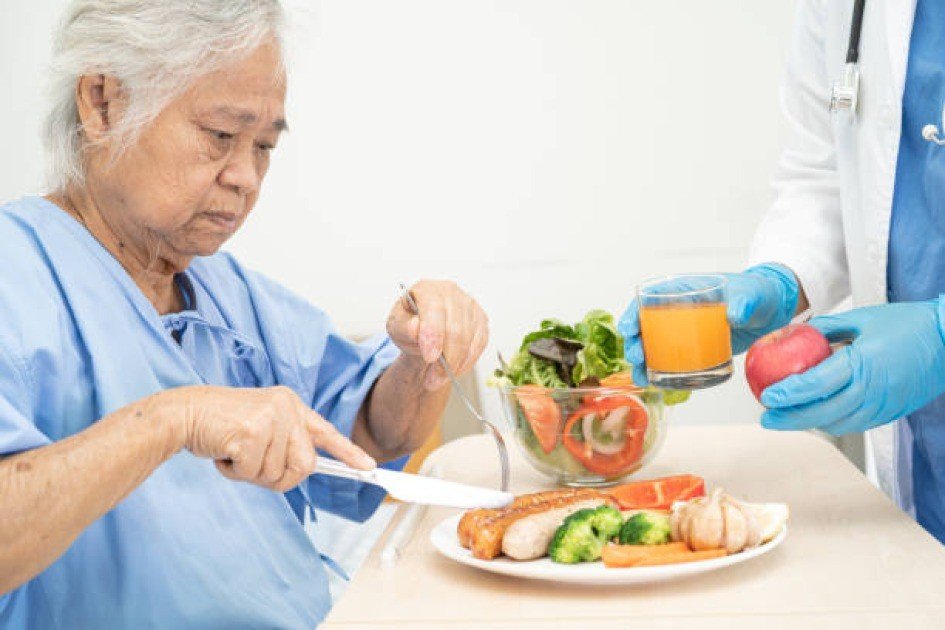
Anti-Inflammatory Diet
Chronic inflammation accelerates aging, exacerbates joint pain, and impairs mobility. Adopting an anti-inflammatory diet can improve overall wellness, promoting an active lifestyle.
Understanding Inflammation and Its Impact on Mobility
Proper nutrition can effectively combat chronic inflammation, the primary cause of age-related diseases, by promoting healthy dietary choices that either fuel or fight this inflammatory process.
The Best Anti-Inflammatory Foods for Joint Health
A balanced diet, rich in antioxidants, omega-3 fatty acids, and phytonutrients, is essential for reducing inflammation.
- Fatty Fish (Salmon, Mackerel, Sardines): Fish high in omega-3s helps lower inflammatory markers. Advanced Omega-3 Fish Oil Supplement is a smart choice for those seeking superior joint and heart health due to its high omega-3 content.
- Leafy Greens (Spinach, Kale, Swiss Chard): Packed with polyphenols and vitamins that protect joints.
- Berries (Blueberries, Strawberries, Blackberries): Powerful antioxidants that fight oxidative stress.
- Turmeric and Ginger: Contain curcumin and gingerol, compounds known to reduce inflammation.
- Nuts and Seeds (Walnuts, Chia, Flaxseeds): Provide essential fatty acids that combat inflammation.
Foods to Avoid: Inflammatory Triggers
Certain foods can exacerbate inflammation and should be minimized or eliminated.
- Refined Sugars and Processed Carbohydrates: Cause rapid spikes in blood sugar, increasing inflammation.
- Trans Fats (Hydrogenated Oils): Found in margarine, baked goods, and fried foods, these fats are linked to chronic inflammation.
- Red and Processed Meats: High in advanced glycation end-products (AGEs), which promote inflammation.
- Excess Alcohol and Caffeine: Contribute to dehydration and increased inflammatory markers.
The Role of Hydration in Combating Inflammation
Hydration is crucial for joint lubrication and inflammation reduction. Start your morning with warm lemon water and electrolyte-enriched hydration powder for cellular hydration and recovery.
Supplements to Enhance an Anti-Inflammatory Diet
Whole foods should be the foundation of any diet, but supplements can provide additional support.
- Curcumin (Turmeric Extract): Premium Curcumin Supplement with BioPerine is a potent anti-inflammatory agent that outperforms over-the-counter pain relievers due to its maximum absorption for superior results.
- Collagen Peptides: Improve joint flexibility and skin elasticity.
- Probiotics: Support gut health, which directly influences inflammation levels.
- Magnesium: Helps relax muscles and reduce inflammatory responses.
Longevity and Inflammation Control
Chronic inflammation accelerates biological aging, making a long-term anti-inflammatory diet beneficial for preserving independence and vitality. It can also improve cognitive function.
Simple Anti-Inflammatory Meal Plan
Here is a sample daily meal plan to assist in starting a new diet:
- Breakfast:
- Avocado toast on whole-grain bread with flaxseeds
- Green tea with lemon
- Lunch:
- Grilled salmon with spinach and quinoa salad
- Olive oil and balsamic vinaigrette
- Snack:
- Greek yogurt with fresh berries and walnuts
- Dinner:
- Stir-fried tofu with turmeric-infused brown rice and steamed broccoli
- Chamomile tea for relaxation
Organic Turmeric Spice Blend is a healthy meal addition that enhances anti-inflammatory benefits in cooking.
A Long-Term Strategy for Vitality
An anti-inflammatory diet empowers individuals through smart choices, incorporating nutrient-dense foods, hydration, and targeted supplements for increased mobility, reduced pain, and long-term vitality.
Here are a few strategies:
- Eat more anti-inflammatory foods like fatty fish, greens, and berries.
- Steer clear of processed foods, refined sugars, and trans fats.
- Stay hydrated and support your diet with high-quality supplements.
- Focus on long-term habits for lasting benefits.
Explore an all-in-one anti-inflammatory supplement pack designed for optimal joint and heart health.
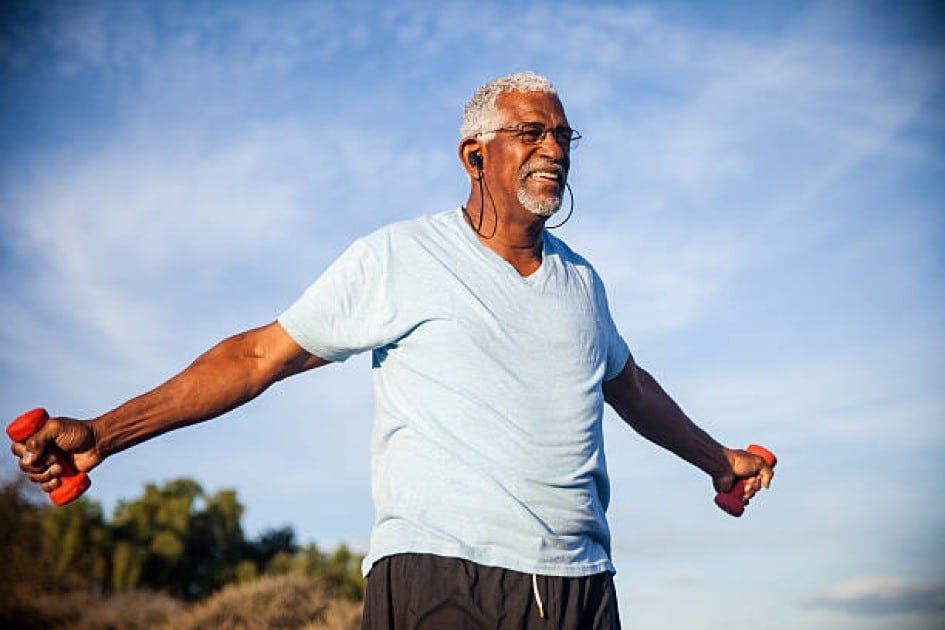
Bone Health Through Diet and Exercise
As an individual’s age, preventing osteoporosis is crucial for maintaining strong bones. By combining nutrition, exercise, and lifestyle adjustments, individuals can enhance bone density and ensure lifelong skeletal strength.
This section delves into the strategies for enhancing bone health, providing expert advice, scientifically supported recommendations, and practical steps for immediate implementation.
The Science Behind Bone Loss and Aging
As people age, bone remodeling slows, leading to decreased bone mass and structural deterioration. Dietary choices and weight-bearing exercises can help reduce bone loss.
Factors like hormonal changes, sedentary lifestyle, poor nutrition, and chronic inflammation accelerate bone loss, and addressing these proactively can significantly reduce the risk of osteoporosis.
The Essential Nutrients for Strong Bones
Aging bones lose density, are prone to fractures and osteoporosis. Nutrients influence strength, prevent deterioration, and support mobility. Understanding these nutrients is crucial for a pain-free lifestyle.
Calcium: The Foundation of Bone Health
The National Institutes of Health recommends adults over fifty consume 1,200 mg of calcium daily for bone building, and seniors should consider supplementing high-quality calcium products.
Best Calcium Sources:
- Dairy Products: Milk, yogurt, and cheese
- Leafy Greens: Turnip greens, collard greens, and spinach
- Nuts & Seeds: Almonds and chia seeds
- Calcium-Fortified Foods: Orange juice, cereals, and plant-based milks
Vitamin D: Enhancing Calcium Absorption
Vitamin D is crucial for calcium absorption, and supplementation with high-potency Vitamin D3 drops may be necessary for optimal bone health.
Magnesium and Vitamin K2: The Overlooked Bone Strengtheners
Magnesium converts Vitamin D into active form, while Vitamin K2 directs calcium into bones. Premium Bone Health Complex provides all-in-one bone support.
Top Food Sources:
- Magnesium: Nuts, seeds, whole grains
- Vitamin K2: Grass-fed dairy, egg yolks, fermented foods
Exercise Strategies to Improve Bone Density
Exercise is essential for maintaining bone density, preventing bone loss, and promoting strength and resilience through weight-bearing activities, strength training, and balance exercises.
With the right strategies, bones can remain strong, mobility remains intact, and independence continues for years. Taking control of bone health is empowering and can lead to lasting benefits.
Weight-Bearing Exercises: Strengthening the Skeletal Framework
Resistance training significantly reduces fracture risk by strengthening bones and promoting bone repair.
Adjustable Dumbbells for Seniors are a great option for home strength training, offering effective weight-bearing exercises that can be done safely. Here are the most effective weight-bearing exercises to choose from:
- Strength Training: Lifting moderate weights two to three times per week.
- Walking & Hiking: Low-impact options to enhance bone resilience.
- Bodyweight Exercises: Squats, lunges, and push-ups strengthen critical skeletal regions.
Balance and Flexibility: Preventing Falls
The Best Stability Board for Seniors offers guided at-home balance training, emphasizing the importance of balance and flexibility training, including yoga and tai chi, in reducing fall risks.
- Recommended Weekly Routine:
- 2-3 sessions of yoga or tai chi
- Daily stretching exercises to improve mobility
- Core-strengthening activities like Pilates
The Role of Anti-Inflammatory Nutrition in Bone Health
Chronic inflammation accelerates bone breakdown, necessitating the use of anti-inflammatory foods like Organic Turmeric Curcumin Supplement for effective anti-inflammatory support.
- Key Anti-Inflammatory Foods:
- Fatty Fish: Salmon, sardines, and mackerel
- Turmeric & Ginger: Powerful natural anti-inflammatories
- Berries & Leafy Greens: Rich in antioxidants
Lifestyle Factors That Support Bone Strength
As we age, our bones lose strength, becoming more fragile and prone to fractures. Maintaining bone health requires a holistic lifestyle, including daily choices like diet and physical activities.
Integrating healthy habits like exercise, nutrition, and stress management can improve bone density, reduce fracture risk, and ensure independence, vitality, and confidence.
The Importance of Quality Sleep
Poor sleep quality is linked to lower bone density, and adults should aim for 7-9 hours of sleep per night for optimal bone repair and regeneration.
- Sleep Optimization Tips:
- Maintain consistent sleep schedules
- Reduce blue light exposure before bed
- Use a high-quality mattress for spinal support
The best sleep aid for bone health is essential for enhanced sleep support.
Reducing Bone-Damaging Habits
- Avoid Excessive Alcohol & Caffeine: Both interfere with calcium absorption.
- Quit Smoking: Tobacco use is a major contributor to bone loss.
- Maintain Healthy Weight: Extreme weight loss can reduce bone mass.
The Path to Stronger Bones
Osteoporosis can be prevented through proper nutrition, resistance training, and mindful lifestyle habits, which not only enhance bone density but also prolong life. Explore top-rated osteoporosis supplements and other bone health products for a healthier and more active future.
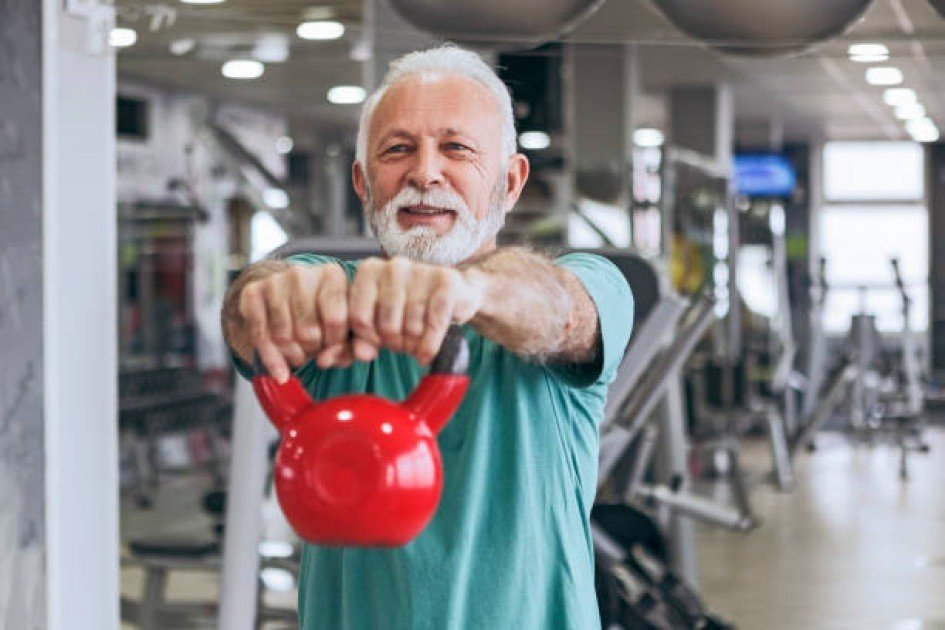
Workouts for Cardiovascular Fitness
Cardiovascular fitness is crucial for overall well-being and longevity. A well-structured exercise routine can improve heart health, lower blood pressure, and boost circulation. Expert insights and cutting-edge solutions are used.
The Science Behind Cardiovascular Training
Cardiovascular exercise strengthens heart muscle, improves oxygen efficiency, and promotes better blood flow, but selecting the right type is crucial for maximizing benefits and minimizing risks.
The Top Cardio Workouts for Heart Health
This guide provides top cardio workouts for heart health, promoting a healthier lifestyle by strengthening the heart muscle, improving circulation, reducing blood pressure, and reducing heart disease risk.
Walking: The Foundation of Cardiovascular Fitness
Walking for 150 minutes per week can reduce heart disease risk, and investing in Smart Walking Shoes with Shock Absorption can enhance comfort and prevent joint strain.
Swimming: A Full-Body, Low-Impact Workout
Aquatic resistance gloves and low-impact aqua jogging belts provide water-based exercises for added intensity, enhancing lung capacity, muscle strength, and circulation without excessive joint strain.
Cycling: Boosting Heart Rate Without Overloading Joints
The Recumbent Exercise Bike with Heart Rate Monitor offers safe, efficient training for cycling, a powerful cardiovascular workout that engages major muscle groups and improves heart efficiency.
Dance-Based Workouts: Fun, Engaging, and Heart-Healthy
Online dance fitness classes offer activities like Zumba, ballroom dancing, and low-impact aerobics for various fitness levels, enhancing cardiovascular endurance and cognitive function.
High-Intensity Interval Training (HIIT): Maximizing Efficiency
Modified HIIT workouts, traditionally used by younger athletes, are proving beneficial for cardiovascular improvement by alternating short bursts of activity and controlled rest periods.
The Role of Heart Rate Monitoring in Exercise
Wearable fitness technology, such as Smart Heart Rate Monitor Watch with ECG capabilities, helps individuals monitor heart rate zones, ensuring optimal intensity without overexertion.
Recovery and Heart Health: The Missing Link
Many people neglect the importance of recovery, a crucial aspect of cardiovascular wellness, which requires adequate rest, hydration, and proper nutrition for muscle repair and heart rate regulation.
- Hydration Tip: Dehydration can increase heart strain. Always have Electrolyte-Enhanced Hydration Tablets on hand.
- Restorative Practices: Consider gentle yoga, deep breathing, and foam rolling to support cardiovascular recovery.
Common Concerns & How to Overcome Them
Individuals often hesitate to start a new exercise routine due to fear of injury or health issues, but with proper guidance and gradual progression, cardiovascular training remains safe and effective.
- Concern: “I have arthritis, and I am wondering if exercise can worsen my joint pain.”
- Solution: Opt for low-impact activities such as swimming, cycling, or elliptical training. Wearing Compression Support Braces can enhance stability and minimize discomfort.
- Concern: “I am unsure of how to maintain my physical activity at home without access to a gym.”
- Solution: Home-based workouts using Portable Cardio Equipment provide an effective alternative.
The Future of Cardiovascular Fitness: Innovations in Heart Health
Smart fitness technology, AI-driven training programs, and virtual coaching are revolutionizing home-based heart health maintenance.
Strengthening Your Heart for a Healthier Future
Investing in cardiovascular health today boosts energy, vitality, and longevity. Utilize expert workouts and fitness tools to optimize heart function and enjoy an active lifestyle.
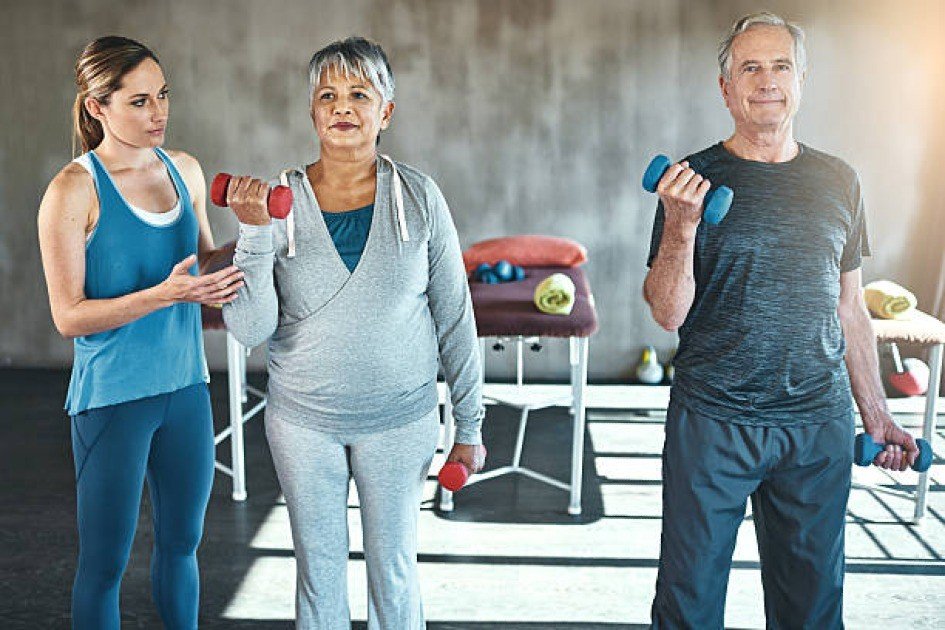
Joint-Friendly Workouts
Arthritis, a prevalent mobility issue, should not deter individuals from maintaining an active lifestyle, as exercise can alleviate stiffness, enhance flexibility, and improve overall well-being.
We will explore the most effective joint-friendly workouts, focusing on their comfort, safety, and long-term mobility benefits.
The Science of Arthritis and Movement
Arthritis causes joint inflammation, but avoiding movement can worsen symptoms. Gentle exercises can increase blood circulation, reduce inflammation, and maintain joint function, according to the Arthritis Foundation.
- How Exercise Supports Joint Health
- Lubricates joints and reduces stiffness
- Strengthens surrounding muscles for better joint support
- Enhances flexibility and range of motion
- What to Avoid
- High-impact activities (e.g., running on hard surfaces)
- Sudden, jerky movements that strain the joints
- Excessive resistance training without proper warm-up
Best Low-Impact Exercises for Joint Health
Physiotherapists and mobility experts recommend the following exercises for effective arthritis management:
Water-Based Workouts: Hydrotherapy & Aqua Aerobics
Aqua Therapy Dumbbells and Non-Slip Pool Shoes are lightweight, effective resistance training tools for water workouts, especially beneficial for arthritis patients due to their buoyancy and full-body movement.
- Why It Works:
- Water supports body weight, reducing joint strain
- Gentle resistance strengthens muscles without impact
- Improves circulation and reduces stiffness
Gentle Yoga for Mobility and Pain Relief
The Yoga Mat and Blocks provide extra cushioning for joints during stretches, while the Yoga Blocks help modify poses for improved flexibility, balance, and relaxation.
- Top Poses for Arthritis:
- Cat-Cow Stretch: Loosens the spine and reduces stiffness
- Seated Forward Bend: Enhances lower body flexibility
- Warrior II: Strengthens leg muscles while being easy on the knees
Cycling: A Low-Impact Cardio Option
The Recumbent Exercise Bike offers superior back support and reduces knee strain. While the Pedal Exerciser for Seniors is compact and perfect for home use. They are both safe and effective ways to maintain cardiovascular health without excessive stress on the knees and hips.
- Why It is Beneficial:
- Engages leg muscles without sudden pressure
- Helps maintain knee flexibility and reduce stiffness
- Provides an effective cardiovascular workout
Resistance Band Workouts: Strengthening Without Strain
The adjustable resistance bands are designed for all fitness levels and feature ergonomic hand grips for improved grip strength, reducing injury risk.
- Best Moves for Arthritis Relief:
- Seated Leg Extensions: Improves knee stability
- Shoulder Rotations: Enhances shoulder mobility
- Gentle Bicep Curls: Strengthens arms without excessive strain
Pain-Free Workouts
Pain-free workouts can benefit seniors with chronic pain or past injuries by adjusting exercises to their body’s needs, promoting mobility, strength, and overall well-being without compromising joints.
Warm Up Before Every Session
Starting with 5-10 minutes of gentle movements like shoulder rolls or slow leg swings can prepare joints for activity and decrease stiffness.
Prioritize Post-Workout Stretching
Stretching enhances flexibility and prevents stiffness, with a particular emphasis on slow, deep stretches aimed at the most affected joints.
Use Proper Footwear to Support Joints
Orthopedic Walking Shoes offer added arch support and stability, reducing joint impact and promoting shock-absorbing, non-slip footwear.
Modify Exercises When Needed
It is crucial to listen to your body and adjust movements, reduce repetitions, or use support equipment if discomfort occurs.
Is Exercise Safe for Severe Arthritis?
Low-impact physical activity, such as stretching, aquatic therapy, and guided mobility exercises, is safe for arthritis patients, improving pain and quality of life, and should be supervised by a licensed physical therapist.
Moving Toward Pain-Free Vitality
Arthritis can be overcome through low-impact exercises, joint-supporting equipment, and consistent routines, promoting mobility, pain relief, and longevity, strength, and vitality at any age.
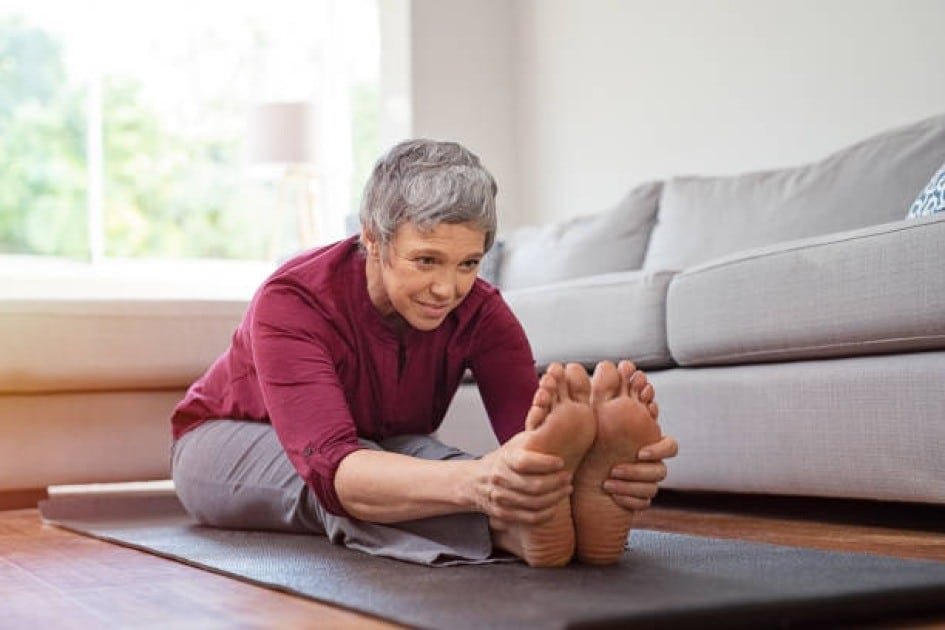
Recovery and Sleep
This section discusses the importance of recovery and sleep in fitness, the science behind sleep and muscle repair, and practical strategies to improve both.
The Science Behind Recovery: Why Rest Matters
Physical activity causes microtears in muscle fibers, essential for growth. Proper recovery involves structured rest, proper hydration, and smart supplementation to prevent chronic fatigue and injury risk.
Sleep and Muscle Repair: The Hidden Connection
Sleep is crucial for physical recovery and growth hormone release. Avoid blue light 90 minutes before bedtime and focus on relaxation techniques for improved sleep. During sleep, the body releases growth hormone, which aids in various physiological processes:
- Muscle regeneration
- Cellular repair
- Cognitive function improvement
- Immune system strengthening
The Role of Active Recovery
Compression Therapy Wraps are ideal for faster muscle recovery, promoting circulation, reducing stiffness, and enhancing muscle recovery through low-intensity activities. Some effective strategies include:
- Walking: A light, 20-minute stroll can increase blood flow and speed up recovery.
- Stretching & Mobility Drills: Incorporating flexibility exercises reduces soreness and prevents stiffness.
- Hydrotherapy: Alternating between hot and cold-water immersion aids in reducing inflammation.
Nutritional Strategies for Faster Recovery
Post-exercise nutrition significantly influences recovery speed, with a balanced intake of protein, healthy fats, and micronutrients supporting muscle repair and reducing inflammation.
- Protein Power: Aim for at least 25-30g of protein per meal to maximize muscle protein synthesis.
- Omega-3 Fats: Found in fatty fish and flaxseeds, omega-3s reduce inflammation and support joint health.
- Magnesium & Zinc: Essential for deep sleep and muscle relaxation.
Sleep Optimization: Practical Tips for Deep, Restorative Rest
The Smart Sleep Tracker offers real-time sleep analysis and coaching, highlighting the importance of habit adjustments and environmental changes in enhancing sleep quality. Consider the following evidence-based strategies:
- Maintain a Consistent Sleep Schedule: Going to bed and waking up at the same time daily helps regulate circadian rhythm.
- Optimize Bedroom Environment: Keep the room cool, dark, and quiet to enhance melatonin production.
- Use Sleep-Tracking Technology: Devices that monitor sleep cycles provide valuable insights into sleep patterns.
Recovery Mistakes to Avoid
Overtraining, neglecting hydration, and relying solely on painkillers can lead to chronic fatigue, injury, and slow muscle repair, causing discomfort and stiffness.
Make Recovery a Priority
Compression Therapy Wraps, Magnesium Sleep Support Supplement, and Smart Sleep Tracker aid muscle recovery, promote deep sleep, and enhance vitality for long-term health and fitness success.
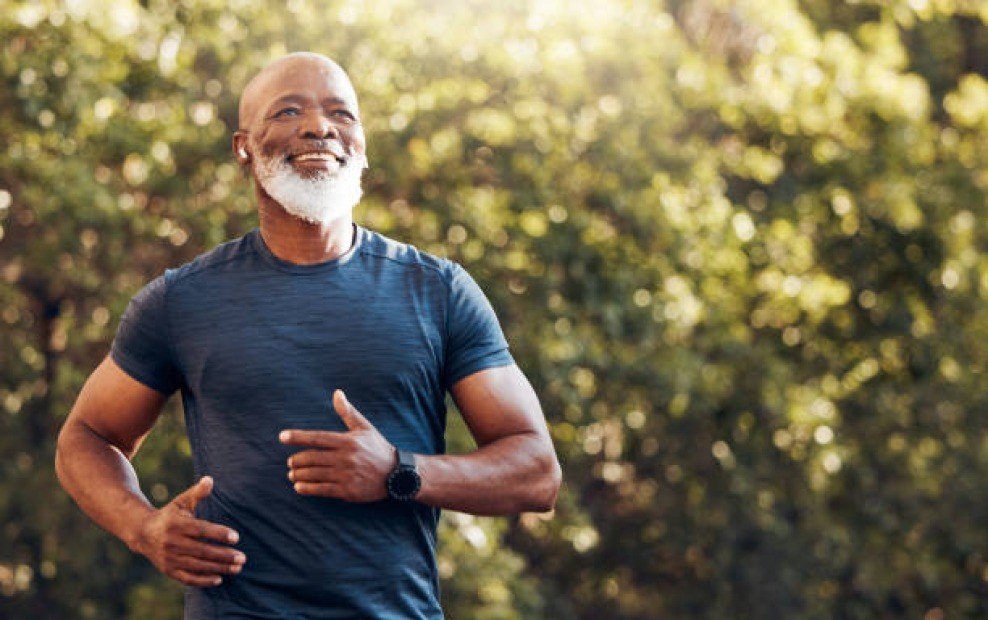
Stress and Fitness in an Active Lifestyle
Stress and fitness are interconnected, with moderate physical activity reducing stress but chronic tension hindering well-being. Integrating relaxation techniques enhances fitness benefits.
Science Behind Stress and Physical Performance
Stress triggers cortisol release, causing muscle breakdown and inflammation. Chronic stress can affect metabolism, increase fat storage, and slow workouts. Mitigating stress and maintaining an active lifestyle is crucial.
How Stress Sabotages Fitness Goals
Stress significantly impacts both physical and mental health, hindering the ability to maintain a consistent fitness routine. The consequences include:
- Increased Cortisol Levels: Elevated cortisol leads to fatigue, muscle loss, and stubborn weight gain.
- Poor Sleep Quality: Inadequate rest impairs recovery, reducing muscle repair and energy levels.
- Elevated Blood Pressure: Chronic stress increases the risk of cardiovascular issues, complicating workout endurance.
- Decreased Motivation: Mental exhaustion lowers enthusiasm for maintaining an active lifestyle.
The Role of Relaxation in Enhancing Fitness and Vitality
Integrating relaxation techniques into fitness routines enhances muscle recovery, mental clarity, and long-term energy levels, promoting physical resilience and longevity.
Key benefits include:
- Faster Recovery Times: Lower cortisol allows muscles to heal efficiently.
- Improved Performance: A relaxed nervous system enhances coordination and strength.
- Enhanced Heart Health: Reduced stress levels, lower blood pressure and risk of heart disease.
- Optimized Hormone Balance: Stress reduction supports testosterone and growth hormone production, both crucial for muscle maintenance.
Top Relaxation Strategies for an Active Lifestyle
A healthy active lifestyle involves regular exercise, relaxation, and mental health-boosting exercises. Balancing exertion and relaxation enhance resilience and performance, allowing individuals to perform their best.
Deep Breathing and Meditation
Meditation, including diaphragmatic breathing and mindfulness, can activate the parasympathetic nervous system, promote relaxation and reduce tension, and can potentially lower cortisol levels.
Progressive Muscle Relaxation (PMR)
The Massage Therapy Device for Muscle Recovery (PMR) is a tool that systematically tenses and relaxes muscle groups, increasing body awareness, reducing stress, enhancing sleep quality, and alleviating muscle stiffness.
Adaptogenic Supplements for Stress and Energy
The Top-Rated Adaptogen Formula is a blend of herbs and natural compounds that aids in stress management, boosting physical stamina and mental clarity. Popular adaptogens include:
- Ashwagandha: Reduces cortisol and improves endurance.
- Rhodiola Rosea: Enhances focus and combats fatigue.
- Magnesium Glycinate: Promotes muscle relaxation and recovery.
Restorative Sleep Optimization
The Premium Sleep Support Supplement is a vital supplement for maintaining hormonal balance, muscle repair, and overall fitness progress, as sleep deprivation can lead to increased stress levels and performance disruptions.
Sleep-Enhancing Strategies:
- Maintain a consistent bedtime schedule.
- Reduce exposure to blue light before sleep.
- Use natural sleep aids like valerian root or melatonin.
The Link Between Nature, Relaxation, and Exercise Performance
A study in the Journal of Environmental Psychology found that 20 minutes of outdoor exposure can significantly reduce stress hormones and improve physical recovery.
- Outdoor workouts improve oxygen intake and energy production.
- Natural settings reduce exercise-related fatigue and increase endurance.
- Exposure to sunlight enhances Vitamin D levels, crucial for bone health and immunity.
Technology and Relaxation: Smart Tools for Stress-Free Fitness
Modern technology provides innovative solutions for tracking stress levels and optimizing workouts, with smart devices monitoring heart rate variability, a key indicator of nervous system balance.
- Top Smart Devices for Stress and Fitness Monitoring:
- Heart Rate Variability Trackers: Measure stress response and recovery time.
- Wearable Sleep Monitors: Track deep sleep cycles and rest quality.
- Breathing & Meditation Apps: Provide guided relaxation techniques.
- Wearable Stress Management: Provide real-tine feedback on stress
Mastering Relaxation for Peak Performance
Integrating stress management techniques into fitness regimens is crucial for long-term vitality and energy, while relaxation enhances endurance, accelerates muscle recovery, and optimizes overall health.
Adopting stress-reducing strategies like meditation, progressive muscle relaxation, adaptogenic supplements, and smart technology can enhance physical resilience, mental clarity, and sustainable fitness progress.
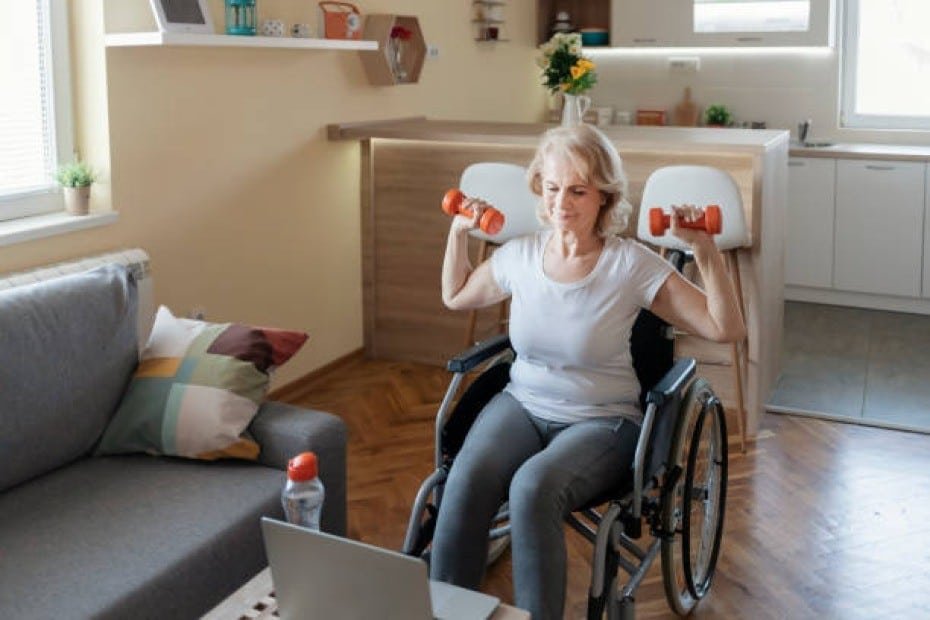
Adaptive Fitness Equipment for Seniors
Modern adaptive fitness equipment helps older adults maintain an active lifestyle without injury by enhancing physical well-being through technology-driven, ergonomically designed tools, ensuring safety and appropriate choice for individual needs.
Why Adaptive Fitness Equipment is Essential for Aging Bodies
Investing in adaptive fitness tools can help older users maintain an active lifestyle while minimizing discomfort and injury risks, while maximizing strength and flexibility.
Dr. Michelle Carter, a senior physiotherapist, emphasizes the importance of adaptive solutions in enhancing the support and adjustability of standard fitness equipment for older adults.
Ergonomic Strength Training Equipment
Ergonomic strength training equipment is revolutionizing the fitness industry by promoting natural body movements and reducing joint and spine stress, promoting strength, mobility, and overall wellness.
Resistance Bands with Adjustable Tension
Theraband Resistance Bands Set offers a safe, customizable, and low-impact alternative to heavy weights for effective strengthening, enhancing strength, flexibility, and reducing joint stress.
Hydraulic & Pneumatic Strength Machines
Strength Machines feature hydraulic and pneumatic resistance systems for smooth, controlled movement, making them ideal for older adults with varying fitness levels.
Joint-Friendly Cardiovascular Machines
Joint-friendly cardiovascular machines are safe, gentle, and effective fitness tools for seniors, promoting heart health and joint protection, making them ideal for recovery and arthritis management.
Recumbent Bikes: Reducing Joint Pressure
Recumbent bikes, like the Schwinn, offer a comfortable, effective cardio workout, supporting the lower back, reducing knee stress, and improving cardiovascular endurance and spine protection.
Seated Ellipticals: Low-Impact, High Results
Cubii Total Body is a compact, app-integrated, and joint-friendly elliptical that offers cardiovascular benefits, increased stamina, coordination, and reduced fall risk for those who find standing challenging.
Mobility and Balance Support Tools
Mobility and balance support tools, such as walking aids and balance trainers, enhance seniors’ independence, health, and confidence, promoting longer activity and a more empowered life.
Balance Trainers and Stability Balls
Bosu Balance Trainer is a popular rehabilitation and strength training tool, enhancing core muscle strength, coordination, proprioception, fall risk reduction, and stabilizing muscle stability in older adults.
Parallel Bars for Assisted Training
The Bongkim Parallel Bars are height-adjustable, slip-resistant, and essential for home use, providing stable support for independent movement, strengthening stabilizer muscles, and building confidence.
Smart Fitness Technology for Personalized Training
Smart fitness technology is revolutionizing personalized training by providing real-time feedback, tracking reps, and measuring body response to exercises, enabling faster, efficient progress and empowering individuals to achieve their fitness goals.
Wearable Fitness Trackers
Fitbit Charge 6 offers heart rate monitoring, ECG scanning, stress management, and real-time health data, promoting accountability and motivation through wearable fitness trackers.
Virtual Fitness Programs and Smart Home Gyms
Mirror Interactive Home Gym offers live and on-demand classes with real-time feedback, providing structured workouts, motivation enhancement, and flexibility in scheduling for seniors.
Choosing the Right Adaptive Fitness Equipment
Choosing adaptive fitness equipment based on mobility, fitness goals, and medical needs is crucial for long-term success. It should prioritize joint protection, ergonomic design, and adjustability.
Final Thoughts
Smart fitness strategies and fueling maintain strength, flexibility, and energy for independent living. Healthiest individuals adapt and thrive, embracing fitness for everyone, starting small and staying consistent.
Home Workouts vs. Gym Training: What is Best for Seniors?
Seniors often choose between home workouts and gym training, based on personal preferences, physical limitations, and fitness goals, with home workouts providing privacy and gym training providing specialized equipment.
Balancing flexibility, safety, and results is crucial. Understanding these options helps make informed decisions that enhance physical and mental well-being.
The Advantages of Home Workouts for Seniors
Home workouts are revolutionizing older adults’ fitness routines, offering personalized, accessible, and sustainable options, allowing seniors to work at their own pace and modify exercises as needed.
Freedom and Flexibility
Home workouts are perfect for seniors with busy schedules or those who prefer a personalized approach, eliminating concerns about commuting, gym memberships, or crowded spaces.
Accessibility
Home workouts for seniors with mobility challenges or rural living can be practical using resistance bands, dumbbells, or bodyweight exercises for affordable, versatile strength training.
Affordability
Home workouts reduce costs by eliminating gym memberships, travel, and personal trainers. Online resources offer free or low-cost plans, while investing in equipment like Bowflex Home Gym provides structured approaches.
The Benefits of Gym Training for Seniors
As we age, maintaining a healthy lifestyle is crucial, and gym training offers life-enhancing benefits for seniors. Regular workouts boost energy levels, maintain independence, and improve cardiovascular health.
By incorporating tailored exercises, seniors can strengthen muscles, improve bone density, and balance, leading to a more fulfilling life. Gym training is not just about lifting weights or aesthetics.
Social Interaction
Gym memberships provide seniors with access to group fitness classes, allowing them to socialize and build relationships while staying active and active.
Fitness instructors in gyms offer personalized guidance to seniors, ensuring safe and correct exercise performance, especially for those with health issues like arthritis or osteoporosis.
Advanced Equipment
Gyms provide advanced fitness equipment, including specialized machines for cardiovascular, resistance, and strength-building, which may not be available at home.
Resistance Machines for Seniors offer low-impact exercises that strengthen the upper body without straining joints, can be adjusted to individual needs, and reduce injury risk.
For beginners at the gym, consider collaborating with a personal trainer for initial sessions to ensure proper form and a customized routine.
Which Option is Right for You?
The choice between home workouts and gym training depends on your lifestyle, fitness level, and personal preferences, despite both having their advantages.
- Home Workouts May Be Better for You If:
- You prefer a private and comfortable environment
- You have time or mobility constraints
- You are on a tight budget
- Gym Training May Be Better for You If:
- You seek expert supervision and guidance
- You enjoy social interactions and group classes
- You have access to a well-equipped gym
A hybrid approach, combining home workouts for flexibility and gym training for structured sessions, offers variety and consistency in senior fitness.
A senior can create a balanced fitness routine by combining gym strength training with cardio and flexibility exercises at home, avoiding monotony and providing motivation.
Final Thoughts
Seniors’ fitness goals influence their choice between home workouts and gym training, with home workouts offering convenience and flexibility, and gym training providing professional equipment and specialized classes.
How to Stay Motivated and Build a Long-Term Fitness Habit
Motivation to exercise is not just about willpower; it is about creating a system that makes fitness an integral part of your lifestyle. Finding joy, purpose, and a routine that fits your life can make exercise enjoyable and a source of vitality.
Understanding the Core of Motivation for Seniors
As we age, maintaining motivation becomes challenging due to physical and health challenges. Understanding psychological aspects is crucial for fostering positive reinforcement and sustainable goals.
Set Realistic, Achievable Goals
SMART goals are essential for long-term success in seniors, providing a framework for tracking progress and preventing overwhelm and frustration.
Setting realistic walking goals and tracking progress using fitness apps or physical journals can boost morale and help maintain daily activity, with Fitbit Charge 6 offering step count, heart rate, and sleep tracking capabilities.
Incorporate Enjoyable Activities into Your Routine
Fitness does not have to be a chore; finding enjoyable activities like dancing, swimming, or gardening can help build long-term habits for physical health.
Google Pixel Watch 3 offers a range of features to enhance your fitness routine, ensuring a personalized and enjoyable experience.
Build a Supportive Network
Support systems like fitness groups, workout friends, and virtual communities can help seniors stay motivated and accountable, enhancing their commitment and accountability.
Reward Yourself for Milestones
Recognize and reward your achievements, whether it is a spa day, a new fitness accessory, or a favorite meal, as these serve as positive reinforcement and motivation.
Integrate Consistency Over Intensity
Long-term success in seniors requires consistency, low-impact activities, and a steady rhythm to prevent burnout and injury, ensuring progress without overwhelming the body.
Consistent exercise routines, such as walking, swimming, or chair yoga, are more effective than sporadic high-intensity sessions. Gentle stretching with a TRX Training Bandit Kit improves flexibility.
Track and Celebrate Small Wins
Track progress, celebrate achievements, and remember that fitness is a marathon, not a sprint. Building a long-term habit takes time but yields rewarding results.
Final Thoughts
Motivation is built through consistency, progress, and purpose. Focus on small, sustainable wins, engaging activities, and a supportive community. Aging does not mean slowing down; it means adapting and thriving. Use EGQINR Smart Bracelet or Google Pixel Watch 3 to monitor activity and encourage consistent exercise.
Overcoming Common Barriers to Senior Fitness
Fitness is not just for young people; it is for anyone who wants to live longer, move better, and feel stronger. Overcoming barriers like aches, pains, low energy, fear of injury, time constraints, financial worries, and lack of motivation is possible.
Lack of Motivation: Finding Your “Why”
Motivation is crucial for seniors to stay active, especially in the face of lack of immediate results, busy schedules, or frustration. Start with 5-10 minutes daily, gradually increasing intensity.
Physical Limitations: Tailoring Workouts for Joint Health
Seniors with joint pain or arthritis often face challenges in exercise. Aquatic Fitness Gear offers low-impact cardio, while mobility and flexibility exercises like stretching and yoga help maintain joint lubrication.
Time Constraints: Prioritizing Fitness in a Busy Schedule
Seniors often struggle to prioritize physical activity, but it is crucial for their mental and emotional well-being. Schedule workouts like appointments and use fitness trackers like Fitbit Charge 6 to stay motivated and track daily activity levels.
Fear of Injury: Starting Slow and Building Confidence
Seniors often face fear of injury when considering fitness programs. To overcome this, start slowly, focus on proper form, and gradually increase intensity, starting with chair exercises or gentle yoga.
Lack of Support: Building a Social Fitness Network
Lack of social support can hinder seniors’ fitness commitment, leading to feelings of isolation. To stay motivated, seniors can join local fitness groups, virtual communities, online forums, or the SilverSneakers Membership, which offers tailored fitness classes.
Access to Equipment: Affordable, Senior-Friendly Solutions
Many seniors lack gym access, but there are senior-friendly fitness products like resistance bands and stability balls that can be used at home for home-based strength training, making it convenient.
Motivation to Continue: Tracking Progress and Celebrating Success
To maintain motivation in seniors’ fitness journey, use fitness trackers like Garmin Vivoactive 5 to monitor steps, sleep, and exercise, ensuring tangible results and encouragement over time.
Staying Safe: Seeking Professional Guidance When Needed
Seeking professional guidance from physical therapists, personal trainers, or fitness coaches can ensure seniors perform exercises safely, optimize routines, and avoid injuries, leading to better health and quality of life.
Final Thoughts
The biggest obstacle to senior fitness is the belief that change is out of reach. By making small, consistent choices, seniors can regain vitality, strengthen their bodies, and boost overall well-being.
Technology in Fitness: How Wearables Can Support Senior Health
Technology and fitness have revolutionized seniors’ health and wellness, with wearable and fitness trackers providing real-time insights and data for maintaining health and preventing complications.
The Role of Wearables in Senior Health
Wearables, such as fitness trackers and smartwatches, are crucial for seniors to maintain an active lifestyle. They provide immediate health monitoring, personalized wellness plans, and fall detection, enhancing their confidence and promoting a proactive approach to health management.
Key Features of Wearables for Seniors
Fitbit Charge 6 is a wearable technology designed for seniors, offering advanced heart rate tracking and sleep monitoring, making it particularly beneficial for their health. Here are some key features that make wearables particularly beneficial for senior health:
- Heart Rate Monitoring: Continuous monitoring of heart rate helps detect any abnormal fluctuations that could signal underlying health issues.
- Step Counters: Encouraging seniors to maintain an active lifestyle, step counters track daily physical activity, motivating them to meet their personal fitness goals.
- Sleep Tracking: Monitoring sleep patterns ensures seniors get enough rest, a key factor in preventing chronic diseases.
- Medication Reminders: Reminders to take medications or follow treatment plans ensure seniors stay on track with their health regimen.
The Impact of Wearable Technology on Chronic Conditions
Wearables can significantly assist seniors in managing chronic conditions like diabetes, hypertension, and cardiovascular diseases by providing continuous tracking and alerts for abnormal readings.
Wearables like the Hellibito Blood Pressure Smart Watch can alert seniors to high or low glucose levels, allowing them to adjust their activity levels or seek medical attention when needed.
Incorporating Wearable Technology into Daily Life
Wearable technology benefits seniors by making them part of their daily routine, offering simple interfaces and voice-controlled features, even for those with limited technology experience.
Tips for Integration:
- Start Slowly: Introduce wearable devices gradually, starting with basic features like step tracking or heart rate monitoring, and gradually expanding to more advanced functions.
- Customize Settings: Customize notifications, reminders, and data displays to suit individual preferences.
- Involve Family Members: Collaborating with family members to review data together can boost motivation and ensure proper use.
By adopting these habits, seniors will become more aware of their health metrics and motivated to adopt a healthier lifestyle.
Security and Privacy: Addressing Concerns
Wearables raise privacy and data security concerns, especially for senior users. Reputable brands prioritize encryption and consent agreements, while seniors should read privacy policies and use security settings.
The Future of Wearables in Senior Health
Apple Watch Series 10 introduces wearable technology, including AI-powered health insights, to revolutionize senior health by tracking physical activity, predicting health risks, and extending healthy life expectancy.
Final Thoughts
Wearable technology is revolutionizing senior fitness by providing real-time health monitoring, enhancing mobility, promoting active aging, and preventing health risks, making it safer and more rewarding.
The Top Senior Fitness Products You Must Try
This section provides a curated list of senior fitness products for seniors, focusing on strength training and mobility enhancement, to enhance their health, quality of life, and safety in their fitness journey.
Resistance Bands for Strength and Mobility
Resistance bands are a low-impact, versatile method for seniors to build muscle, improve flexibility, and prevent injuries. Fit Simplify Resistance Tube Bands are a top choice, offering gradual progression and being lightweight and portable for home and travel use.
Adjustable Dumbbells for Progressive Strength Training
The NUOBELL Adjustable Dumbbells are a top choice for seniors seeking to intensify their strength training routine, offering a wide range of weight options from 5 to 80 pounds.
Recumbent Exercise Bikes for Low-Impact Cardio
The Schwinn 270 Recumbent Bike is a top choice for seniors seeking a comfortable, low-impact cardio workout without straining their joints, offering customizable resistance levels and an ergonomic design for improved posture.
Stability Balls for Balance and Core Strength
TheraBand Exercise Ball is a top choice for seniors for balance exercises, core strengthening, stretching, and posture improvement, due to its durable, non-slip design and versatile use.
Compression Socks for Circulation and Recovery
Physix Gear Sport Compression Socks are designed for seniors to improve circulation, reduce swelling, and enhance recovery, making them ideal for post-workout recovery.
Portable Hand Weights for At-Home Workouts
The Amazon Basics Neoprene Hand Weights are a compact, versatile tool for seniors to enhance their strength training regimen, offering a soft grip and ergonomic design for extended use.
Senior-Friendly Fitness Trackers for Motivation and Tracking
Fitbit Inspire 3 is a user-friendly fitness tracker designed for seniors, providing a sleek and lightweight solution for tracking steps, heart rate, calories burned, and sleep patterns.
Foam Rollers for Muscle Recovery
The TriggerPoint GRID Foam Roller is a popular choice for seniors, providing deep tissue massage, muscle tension relief, and improved circulation for faster recovery.
Non-Slip Yoga Mat for Flexibility and Stretching
Yoga enhances seniors’ flexibility, balance, and mental health. The Gaiam Essentials Thick Yoga Mat offers a non-slip surface for comfortable and stable stretching and balance exercises.
Final Thoughts
Senior fitness products, such as resistance bands and foam rollers, are designed to enhance workout routines, boost health, and promote active living, providing comfort, safety, and effectiveness.
Real Success Stories: Seniors Who Transformed Their Health
Fitness for seniors is not just about appearance; it is about reclaiming independence, reducing pain, and unlocking vitality. Real-life success stories inspire action to overcome arthritis, shedding excess weight, and boosting heart health.
The Power of Determination: Alice’s Journey to Better Mobility
Alice, a 72-year-old retiree with chronic knee pain, decided to incorporate low-impact strength training after learning its benefits.
Alice improved mobility and confidence through gentle strength exercises and balance training, using Fit Simplify Resistance Tube Bands to strengthen leg muscles without causing joint damage, resulting in reduced pain and increased stamina.
Breaking Through Barriers: Robert’s Fight Against Heart Disease
Robert, a 68-year-old with heart disease, found a senior-focused fitness program at his community center, overcoming a struggle to maintain a sedentary lifestyle.
Robert’s fitness plan, incorporating cardio exercises and low-impact cycling using Schwinn Recumbent Bike, significantly reduced his cholesterol levels within six months, leading to improved health and daily walking.
A New Beginning: Sarah’s Weight Loss Transformation
Sarah, a 64-year-old grandmother, lost weight after discovering home fitness programs’ benefits, challenging her belief that weight loss was impossible.
Sarah, through light strength training, low-intensity cardio, portion control, and eliminating processed foods, lost thirty pounds and improved mobility and energy levels within a year.
Overcoming Arthritis: Tom’s Pain-Free Transformation
Tom, 70, experienced knee arthritis, limiting activity. Attending a senior fitness seminar, he discovered that joint-friendly workouts could significantly improve his condition.
Tom alleviated arthritis symptoms through strength training and water aerobics, rebuilding strength. He incorporated anti-inflammatory foods like omega-3 fish and turmeric into his diet.
The Importance of Mental Health: Jennifer’s Story
Jennifer, at 75, experienced depression and isolation, affecting her quality of life. Joining a senior fitness class provided a new perspective on aging.
Jennifer improved her mental and physical health through yoga and mindfulness exercises, reconnected with herself and others, and credits her transformation to the mind-body connection fostered by regular exercise.
A Community Effort: The Senior Fitness Revolution
The senior fitness revolution is a nationwide movement where seniors are taking control of their health through age-appropriate workouts, regular exercise, and informed health decisions.
Seniors are increasingly using fitness technology like Fitbit 6 Fitness trackers and fitness apps for personalized workouts and nutrition advice.
Finding Support: Fitness Communities for Seniors
Success in senior fitness programs is attributed to the sense of community formed by like-minded individuals. Local fitness centers offer classes like yoga and Tai Chi, while online groups provide virtual fitness challenges and community support.
Final Thoughts
The stories of seniors demonstrate that with proper guidance and commitment to movement, anyone can rewrite their health story, and starting small and staying consistent is key to a stronger, healthier life.
Finding the Right Support: Senior Fitness Communities & Resources
Community support and reliable resources, such as online platforms, local fitness groups, and specialized tools, can significantly enhance seniors’ fitness journeys, keeping them motivated and engaged.
Online Senior Fitness Communities: Connecting for Success
The digital age has facilitated seniors to connect with fitness enthusiasts through online communities, providing a safe space for discussing challenges, sharing advice, and celebrating progress.
Join senior fitness forums or Facebook groups for motivational support, like The Senior Fitness Network, where members share experiences, access expert advice, and participate in virtual challenges.
Local Senior Fitness Centers and Programs: In-Person Engagement
Local senior fitness centers offer group fitness classes for older adults, focusing on gentle exercises and fostering lasting friendships. They also provide personalized training programs to meet individual needs.
Look for local YMCA branches or senior community centers offering affordable fitness memberships for older adults, offering a variety of activities like aqua aerobics and Tai Chi.
The Power of Fitness Coaches: Personalized Guidance
A certified personal trainer specializing in senior fitness offers personalized advice, ensuring effective and safe exercises, and tailors’ workouts to fit physical limitations and health conditions.
Ask your trainer about specialized certifications like NAMS Certified Senior Fitness Specialist or ACE Senior Fitness for senior-specific advice. Investing in a personal trainer can prevent future mobility issues.
Fitness Trackers and Wearables: Monitoring Progress and Health
Fitness trackers and wearables assist seniors in monitoring their physical activity, heart rate, and sleep patterns, thereby ensuring they stay on track with their fitness goals.
Fitbit 6 Fitness trackers is a smart fitness tracking device ideal for seniors, offering heart health monitoring, step tracking, and sleep insights, providing valuable data for healthcare providers for informed health decisions.
Government and Non-Profit Resources: Public Health Initiatives
Public health organizations like AARP and local governments are promoting fitness for seniors through accessible resources and programs, including fitness guides and challenges.
Senior Fitness Apps: Fitness at Your Fingertips
Fitness apps provide personalized workout plans, instructional videos, progress tracking, nutrition advice, and community engagement for tech-savvy seniors. Medicare plans often offer free or discounted access to these programs.
Final Thoughts
Identifying the right support is crucial for seniors to maintain a sustainable fitness routine, utilizing resources like online communities, local programs, and wearable technology, thereby promoting a more active, independent lifestyle.
Recap: The Vitality Blueprint: Your Key to Lasting Energy
Maintaining senior vitality requires a holistic approach that includes physical, mental, and emotional wellness. This sustainable lifestyle, incorporating fitness, nutrition, mental sharpness, and recovery, can enhance physical health, independence, and quality of life.
Dr. Richard Stevenson emphasizes the importance of an integrated approach for true vitality in later years, encompassing body activity, mind engagement, and spirit upliftment.
Physical activity, including light stretching, strength training, and aerobic exercise, significantly benefits seniors’ overall well-being. Low-impact exercises promote cardiovascular health and longevity, while senior-friendly equipment like Fit Simplify Resistance Tube Bands facilitates safe muscle building.
Nutrition is crucial for seniors, affecting energy levels and vitality. A balanced diet, including omega-3 fatty acids, fiber, lean proteins, antioxidants, and anti-inflammatory foods, is essential. Supplements like Viva Naturals Omega-3 Fish Oil support long-term vitality.
Mental clarity and emotional well-being are crucial for vitality, especially as we age. Engaging in cognitive exercises, mindfulness, and social activities can reduce mental decline, improve memory, and boost mood.
Recovery is crucial for maintaining energy, and seniors should aim for 7-9 hours of quality sleep each night. Products like the Purple Sleep Mattress can provide a comfortable, supportive sleep experience, especially for those with chronic pain.
Daily relaxation techniques promote inner peace, mental energy replenishment, and improved immune function in seniors, according to research by the National Institute on Aging.
A structured routine, including exercise, meals, relaxation, and social activities, can help seniors maintain energy without feeling overwhelmed, can lead to increased energy levels, sharper cognition, and overall vitality.
Social connections are crucial for seniors, as they promote belonging, combat loneliness, and improve mental health. Participating in fitness groups, online communities, or spending quality time with loved ones can also enhance longevity.
In summary, the vitality blueprint for seniors is a personalized approach that promotes physical activity, nutrition, mental stimulation, emotional well-being, and recovery to enhance longevity and quality of life.
Frequently Asked Questions
How often should seniors engage in physical activity?
Seniors should engage in 150 minutes of moderate-intensity exercise weekly, ideally with two strength training sessions, according to WHO and American Heart Association recommendations, and use Fitbit Charge 6 for tracking.
What are the best exercises for seniors with limited mobility?
Seniors with limited mobility can benefit from low-impact exercises like chair yoga, water aerobics, and seated strength training, with resistance bands for effective seated workouts.
What is the role of supplements in senior fitness?
Supplements like Vitamin D, Magnesium, and Collagen are crucial for seniors’ fitness and health, but should complement a balanced diet, like Osteo Bi-Flex for joint support.
How can seniors prevent falling through fitness?
Fall prevention for seniors involves a targeted fitness program focusing on balance, core, and leg strength exercises, including Tai Chi and balance training, and using a LifePro Vibration Plate.
Can technology assist in senior fitness tracking?
Wearable fitness trackers like Fitbit Charge 6 Fitness and Garmin Venu 3S provide real-time feedback on steps, heart rate, sleep quality, and active minutes, helping seniors stay motivated and on track.
How important is sleep for seniors’ fitness?
Sleep is crucial for muscle recovery, brain health, and energy levels, especially for seniors. Investing in Tempur-Pedic mattresses can improve sleep quality and reduce falls.
What type of diet is best for seniors looking to stay fit?
Seniors should adopt a nutrient-rich diet, including lean proteins, healthy fats, fiber, and complex carbohydrates, with anti-inflammatory foods like turmeric and omega-3 supplements for improved mobility.
Are home workouts as effective as gym workouts for seniors?
Home workouts can be effective when tailored to individual fitness goals, such as strength, flexibility, or balance improvement. Resistance Bands are affordable, versatile tools that can be used in the comfort of the home.
How can seniors build a sustainable fitness routine?
ABC Trainerize offers both in-person and online classes to help seniors maintain a sustainable fitness routine, incorporating cardio, strength training, and flexibility exercises.
How can seniors maintain motivation to stay fit over time?
To maintain motivation in fitness, seniors should make it enjoyable and rewarding by tracking progress, setting goals, and rewarding themselves after milestones using ABC Trainerize.
Should seniors consult with a healthcare provider before starting a fitness program?
Consult with a healthcare provider before starting a new fitness program, especially for seniors with pre-existing medical conditions, for personalized recommendations and safe exercises.

